







28 ‘Kool’ Treats A bad experience inspired a Northern Kentucky entrepreneur to create Kona Ice, a multimilliondollar business
34 A Family Affair Rebecca, George and Seth Romero are passionate about bringing a taste of Italy to Mount Sterling









28 ‘Kool’ Treats A bad experience inspired a Northern Kentucky entrepreneur to create Kona Ice, a multimilliondollar business
34 A Family Affair Rebecca, George and Seth Romero are passionate about bringing a taste of Italy to Mount Sterling
Test your knowledge of our beloved Commonwealth. To find out how you fared, see page 4.
1. William O’Connell Bradley, the uncle of Gov. Edwin P. Morrow, was the first what to hold the office?
A. Independent
B. Republican
C. Foreign-born person
2. William Burke “Skeets” Miller of the Louisville Courier-Journal won which award for his reporting on Floyd Collins being trapped in Sand Cave?
A. Academy Award
B. Grammy Award
C. Pulitzer Prize
3. Danville’s John Fetterman won a Pulitzer Prize in 1968 for “Pfc. Gibson Comes Home,” the story of the body of a Knott County soldier returning home from which war?
A. Korea
B. World War II
C. Vietnam
4. Kentucky native Maurine Dallas Watkins’ experience as a courthouse reporter led to a 1920s stage play that became a 1970s Broadway musical before becoming an Academy Award-winning film. What was the name of the play, musical and film?
A. Terms of Endearment
B. Chicago
C. The Front Page
5. Hocker Female College, later Hamilton College, operated in which Kentucky city from 18691932?
A. Lexington
B. Louisville
C. Walton
6. While many people know that Supreme Court Justice Louis Brandeis is buried under the porch of the University of Louisville’s law school, few know the remains of two professors of French descent are entombed in the administration building of which Kentucky school?
A. Kentucky Wesleyan
B. Transylvania
C. Lindsey Wilson
7. Henry Clay, once a law professor at Transylvania University, taught a student who was the father-in-law of which American president?
A. Zachary Taylor
B. John F. Kennedy
C. Abraham Lincoln
8. Abraham Lincoln, the grandfather of President Abraham Lincoln, was killed in eastern Jefferson County in May 1786 and was a captain during which war?
A. French and Indian War
B. Lord Dunmore’s War
C. American Revolution
9. Before being called Mount Washington, Bullitt County’s oncelargest city was from 1822-1833 appropriately called what?
A. Mount Vernon
B. Monticello
C. Arlington
10. Ten-year-old Virginia Cary Hudson’s series of 10 short essays were turned into a book, O Ye Jigs & Juleps!, in 1962 and earned which distinction?
A. Charges of plagiarism of the Episcopal Book of Common Prayer
B. Banned for its depiction of baptism
C. New York Times bestseller status

© 2025, VESTED INTEREST PUBLICATIONS VOLUME TWENTY-EIGHT, ISSUE 4, MAY 2025
Stephen M. Vest Publisher + Editor-in-Chief
Patricia Ranft Associate Editor
Rebecca Redding Creative Director
Deborah Kohl Kremer Assistant Editor
Ted Sloan Contributing Editor
Cait A. Smith Copy Editor
Jackie Hollenkamp Bentley, Jack Brammer, Bill Ellis, Steve Flairty, Gary Garth, Jessie Hendrix-Inman, Mick Jeffries, Kim Kobersmith, Brigitte Prather, Walt Reichert, Tracey Teo, Janine Washle and Gary P. West
Barbara Kay Vest Business Manager
Katherine King Circulation Assistant
Lindsey Collins Senior Account Executive and Coordinator
Kelley Burchell Account Executive
Kristina Dahl Account Executive
Hal Moss Account Executive
Laura Ray Account Executive
Teresa Revlett Account Executive
For advertising information, call 888.329.0053 or 502.227.0053
KENTUCKY MONTHLY (ISSN 1542-0507) is published 10 times per year (monthly with combined December/ January and June/July issues) for $25 per year by Vested Interest Publications, Inc., 100 Consumer Lane, Frankfort, KY 40601. Periodicals Postage Paid at Frankfort, KY and at additional mailing offices.
POSTMASTER: Send address changes to KENTUCKY MONTHLY, P.O. Box 559, Frankfort, KY 40602-0559. Vested Interest Publications: Stephen M. Vest, president; Patricia Ranft, vice president; Barbara Kay Vest, secretary/treasurer. Board of directors: James W. Adams Jr., Dr. Gene Burch, Gregory N. Carnes, Barbara and Pete Chiericozzi, Kellee Dicks, Maj. Jack E. Dixon, Bruce and Peggy Dungan, Mary and Michael Embry, Judy M. Harris, Greg and Carrie Hawkins, Jan and John Higginbotham, Frank Martin, Bill Noel, Walter B. Norris, Kasia Pater, Dr. Mary Jo Ratliff, Randy and Rebecca Sandell, Kendall Carr Shelton and Ted M. Sloan.
Kentucky Monthly invites queries but accepts no responsibility for unsolicited material; submissions will not be returned.
KENTUCKYMONTHLY.COM


‘Get
As always, I enjoyed the latest edition of Kentucky Monthly. I am not exactly a sports fan, but I read Tommy Druen’s article on Kentucky’s baseball history with delight (April issue, page 36).
I thought of the enclosed photograph and thought I would share it with you, hoping that you might forward it to Mr. Druen.
“Get a Cold Drink” is an image from the scrapbook of my great-aunt Rosalie Dearinger Nickoson taken (probably by her) at a baseball game in Lexington during or just before World War I. I wish I knew more.
One of the three ladies may be my grandmother, Gracie Jack (Dearinger). I don’t know who the players are or even the identity of the team they represent, but I have always loved the charm of the photo and its
caption, and I hope that you do, too.
Kevin Lane Dearinger, Lexington

The articles about Renfro Valley and Science Hill Academy in the March issue were interesting. We’ve stayed at Berea a number of times but never have made it to a concert at Renfro Valley, just a short drive south of Berea. We need to get there sometime.
We were at Pine Mountain State Resort Park a couple of weekends ago and
enjoyed exploring some places in that area, including the Red Bird Mission/Clinic/School near Beverly and the Henderson Settlement in Frakes, as well as Cumberland Gap.
Thank you for continuing to produce a quality, interesting magazine. And thank you for including our photo in the March Mag on the Move (page 6).
Anne Keller, Seymour, Indiana
I just finished reading Bill Ellis’ article “Evolution and Me” (March issue, page 56). Once again, I found Bill to be the voice of reason. I wish we had more folks like Bill in positions of influence around Kentucky and our nation.
I enjoy his articles and others in Kentucky Monthly Keep up the great work.
Wayne Onkst, Erlanger
We Love to Hear from You! Kentucky Monthly welcomes letters from all readers. Email us your comments at editor@kentuckymonthly.com, send a letter through our website at kentuckymonthly.com, or message us on Facebook. Letters may be edited for clarification and brevity.


Kentucky Monthly’s annual gift guide highlights some of the finest handcrafted gifts and treats our Commonwealth has to offer.

This handy guide to sipping in the Bluegrass State spotlights local breweries, wineries and, of course, distilleries. Discover unique ways to drink in Kentucky, creative cocktail recipes and more.
Even when you’re far away, you can take the spirit of your Kentucky home with you. And when you do, we want to see it!


Marilyn Robie and Gilson Capilouto, both of Lexington, took a backroads hiking trip in the Canadian Rockies.
Terry and Barbara Brown (not pictured) of Louisville visited Bridgetown, Barbados, West Indies and a number of islands in the Caribbean.

May’s Lick residents Terry and Vickie Prather traveled to Huntington Beach, California.
KWIZ ANSWERS 1. B. The 32nd governor, Bradley served from 1895-1899; 2. C. The diminutive, slightly built Miller was able to get close enough to Collins to talk to him, pray with him, and carry food and drink, the C-J noted in 2018; 3. C. Fetterman’s story was about James T. Gibson, who was 24 when he died; 4. B. The film version won six Academy Awards, including Best Picture, in 2002, and starred Renée Zellweger and Catherine Zeta-Jones; 5. A. The state’s first junior college for women was assimilated into Transylvania University in Lexington, along with several other struggling schools; 6. B. The bodies of Constantine Rafinesque, a professor of natural sciences, and Sauveur Francois Bonfils, a language and literature professor, rest in Old Morrison, the central image on the city seal of Lexington; 7. C. Robert Todd, the father-in-law of the 16th president, was one of Clay’s students; 8. C. Abraham Lincoln [Linkhorn] (1744-1786) was captain of the Augusta County (Virginia) militia during the American Revolution; 9. A. Named in honor of the first president, the city formerly bore the name of his famous estate; 10. C. Written in 1904 and saved by Virginia Cary Hudson’s mother, the collection was published by Virginia’s daughter, Virginia Cleveland Mayne, in 1962 and sold more than a million copies. It remained on the bestseller list for 66 weeks.



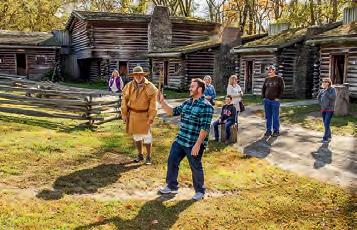



Chef Sara Bradley, the owner and proprietor of the freight house in Paducah, and Noam Bilitzer, the owner and chef of MeeshMeesh
Mediterranean restaurant in Louisville, have been named 2025 James Beard Foundation Award Nominees for Best Chef: Southeast. They are among five nominees in that category.

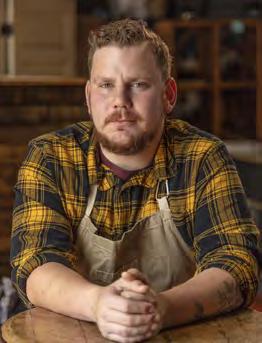
The prestigious James Beard Award is among the highest accolades for chefs and restaurants in the country.
“I’m ecstatic,” Bradley said. “This is a tremendous honor

Mand I’m grateful for the team at freight house—this recognizes all their hard work, too. I’m also hopeful this will encourage more people to explore Paducah and all we have to offer.”
“I’m speechless. So many of my culinary heroes have been recognized by the James Beard Foundation and to share that is such an honor,” said Bilitzer. “I’m incredibly fortunate to be supported by a talented team, especially my chef de cuisine, Alex Hamrick.”
The 2025 James Beard Awards Ceremonies will be held in Chicago on June 16.
ulti-talented Executive Chef Joshua Moore takes on any culinary challenge, including dishes with beef, fish, pastries, pork and more, just like he did a few seasons ago on the Food Network show Chopped, winning an episode titled “Deadly Catch.”
Moore is the executive chef and managing partner at Volare Italian Ristorante in Louisville. Kentucky Derby season brings out all the specialty dishes with only the freshest ingredients. Moore likes to use fresh-caught, fresh-grown and locally made products like Purnell’s “Old Folks” sausage products.
Purnell’s uses true family secret recipes from Italian and German heritage for its bratwurst and Italian sausage, and the family recipe for that “gooo-od” country flavor of Purnell’s “Old Folks” country sausage.
Stop in Volare during May to find out what’s fresh out of the waters of the Atlantic or for some traditional Kentucky flavor.
1 pound Purnell’s Italian sausage
½ cup white wine
½ cup chicken stock
¼ teaspoon ground anise
1 cup canned tomato strips
1 cup canned tomato purée
1 cup heavy cream
1 tablespoon brandy
2 tablespoons chiffonade basil
Salt and pepper to taste
1. In a saucepan brown the Italian sausage.
2. Deglaze pan with wine and stock. Simmer for 5 minutes.
3. Add remaining ingredients and simmer on low for approximately 30 minutes.
4. Enjoy!




LAURA
It’s not often a Booker Prize winner and Pulitzer Prize poetry nominee makes a musical album, but poet Cornelius Eady has done just that. He set some of his poetry to music, and June Appal Recordings released the Cornelius Eady Group’s Don’t Get Dead vinyl album in March.
While the trio is based in New York, “Cornelius and company have long had many admirers at Appalshop, and June Appal Recordings, our in-house record label, is always looking to further explore and widen the net of our catalog,” said Tucker Leighty-Phillips, publicity manager for Applashop.
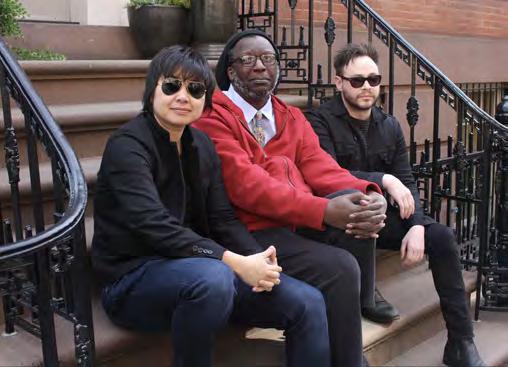
news and hope and dread changed from day to day. At times, it felt like from hour to hour.”
“You knew it had started, but while in the middle of the worst of it, it was hard to know where it was going, or if it was ever going at all. The songs are sort of a loose cycle of that feeling, more like postcards from the trenches.”
Don’t Get Dead originally was released digitally by June Appal in late 2021 amid the COVID-19 pandemic. Like many performers, Eady and bandmates Charlie Rauh and Lisa Liu were in isolation, unable to perform or even to practice and collaborate in person.
“The start is when COVID shut everything down in early March 2020. My wife and mother-in-law and I were in isolation on Long Island,” Eady said. “My mother-inlaw then was in her mid-80s, and we thought it best to be there, thinking it would only be a few weeks, maybe a month or so, but of course, it turned out to be a lot longer and scarier than we thought.”
Eady, Rauh and Liu had recording equipment where they lived, and they recorded and edited remotely so they could still work together.
Rauh had worked with Eady since 2012, so writing music to accompany poetry was not new to him. “The words are the foundation and the message, so my role is to provide a vehicle to deliver that message as best I can,” he said. “When I write parts on guitar, bass or percussion, I am attempting to translate the intention of Cornelius’ words. When I am producing the recordings, I am attempting to build the atmosphere of Cornelius’ storytelling around the musical vehicle.”
Don’t Get Dead mixes a variety of styles and genres. “I would describe it as a type of folk music,” Rauh said, “a melting pot of influences ranging from Appalachian and blues to R&B and funk.
“At its core, the music is deliberate and steady. There’s much more of a focus on intention than on technical prowess. We try to create music that draws people in and doesn’t let them look away.”
As for the lyrics, Eady said, “The best I can say is that COVID was a story without a through line. The
Leighty-Phillips thinks that releasing the album again, this time on vinyl, takes on a historical context. “Now, five years since the beginning of the COVID-19 pandemic, this album takes on new meaning,” he said. “It acts not just as a collection of songs but also as an oral history of that time period. We believe a re-release allows for listeners to have a new experience with Don’t Get Dead through the lens of hindsight.”
Since the world has reopened, the band has returned to live performances. “We continue to perform together as a trio—Cornelius, Lisa Liu and myself—and in certain instances with [violinist] Concetta Abbate,” Rauh said.
“I’m inching toward retirement with teaching [at the University of Tennessee-Knoxville],” Eady said, “and hope when that happens, I’ll have a bit more time to knuckle down on some projects I’ve been thinking about—with Charlie, Lisa and Concetta, of course!”
To order a copy of Don’t Get Dead, visit juneappalrecordings.bandcamp.com.
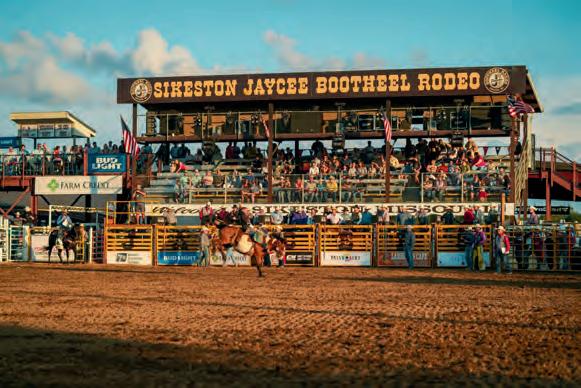





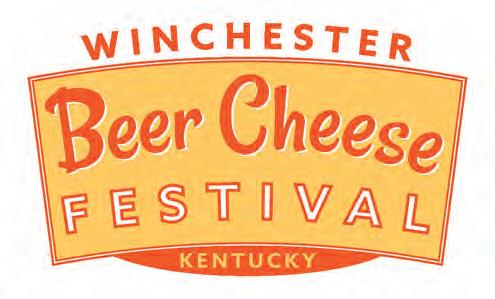



Ahighlight of our annual Food Issue is the Reader Recipe Contest.
For the first time ever, we have a consecutive repeat winner. Julie Hook of Cunningham (Carlisle County), who took home the grand prize last year with her Sweet & Spicy Smoked Gouda Bacon Dip, scored again this year with an inspired pasta dish, Creamy Butternut Squash Pasta.


Chef John Foster, chair of the Culinary Arts Program at Sullivan University’s Lexington campus and owner of The Sage Rabbit restaurant in Lexington, directed the preparation of the dishes, which were judged on appearance, creativity, ease of preparation and—weighted double the other criteria—flavor.

Thank you to all who entered, and congratulations to the winner and finalists!
SPECIAL THANKS TO
Chef John Foster, left, for his expertise and professionalism in preparing the recipes; photographer Rebecca Redding for her scrumptious images; Sullivan University for the use of one of its Culinary Arts Program kitchens and always being an awesome collaborator; Sir Kenn Gray and his Good Knight Inn for providing the grand prize; and judges Sue-Sue and Steve Hartstern Mona Redding Kay Vest and Janine Washle
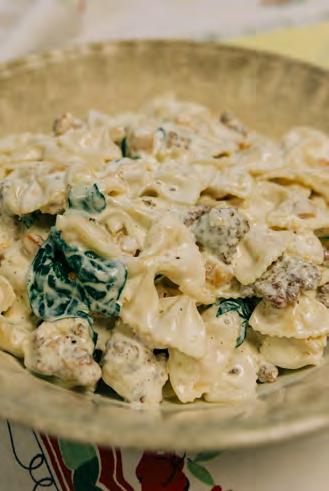

8-10 SERVINGS
Roasted Butternut Squash:
3 cups butternut squash, peeled, seeded and cubed
1 tablespoon olive oil
Salt and pepper to taste
Sausage:
1 tablespoon olive oil
1-2 pounds Italian sausage, casings removed, sausage cooked and crumbled (I use sweet sausage)
Creamy Pasta Sauce:
1 tablespoon olive oil
4 garlic cloves, minced
1½ cups heavy cream
½ cup shredded parmesan cheese
6 ounces fresh spinach
¼ teaspoon salt
¼ teaspoon red pepper flakes
Pasta:
8 ounces farfalle (bow-tie pasta), cooked
Crumble Topping: Combine chopped crisp bacon, roasted pine nuts and toasted breadcrumbs (optional).
1. Preheat the oven to 400 degrees.
2. Toss squash with olive oil and salt and pepper. Spread squash on a lined baking sheet and roast for 30 minutes. Remove from oven.
3. Cook sausage in a medium skillet over medium heat. Stir frequently to brown evenly and crumble sausage.
4. For creamy sauce, in a large skillet, heat olive oil and garlic over medium heat. Cook until garlic starts to soften.
5. Add heavy cream to garlic and bring to a boil. Reduce heat to a simmer, add parmesan cheese, and stir until cheese melts.
6. Add spinach and let cook down until spinach starts to wilt. Add salt and red pepper flakes.
7. Cook pasta in boiling water according to package directions and drain.
8. Add cooked pasta and cooked sausage to the cream sauce. Stir to combine.
9. Add butternut squash to the pasta/ sauce mixture.
10. Top with the crumble topping, if using.
Note: Can substitute sauce with jarred Alfredo sauce for a quick, delicious, savory dish.
“A lifelong Kentucky gal, I love all things Kentucky.”
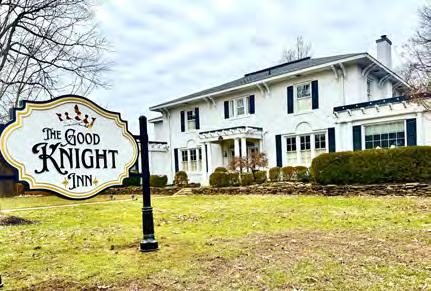
GRAND PRIZE WINNER
JULIE HOOK
CUNNINGHAM, CARLISLE COUNTY
As the grand prize winner, Julie and a guest will receive a two-night stay at The Good Knight Inn bed and breakfast in Paducah. She will enjoy the company of Sir Kenn Gray (a real knight) and the newest iteration of his internationally known interior design prowess in this historic home. A cookbook author, Sir Kenn will lavish Julie and her guest with his sparkling personality and gourmet breakfasts each morning.

8 slices peppered bacon, thick cut
1 pound baby spinach
2 teaspoons roasted garlic paste
1 cup beef stock
¼ cup quick grits
½ cup shredded cheddar cheese
1 premade piecrust
1 small egg, beaten
Glaze:
1 cup sweet onion, diced
1 tablespoon brown sugar, packed
1/8 teaspoon kosher salt
¼ cup Kentucky bourbon
1. Preheat oven to 400 degrees.
2. Fry bacon in a heavy skillet over medium-high heat. Fry until crispy, then place on paper towels to drain. Reserve 2 tablespoons of the bacon grease from the pan and dispose of the remaining grease.
3. Add 1 tablespoon of reserved grease back to the skillet and place over medium heat. Add the spinach and garlic to the hot skillet. Sauté, stirring frequently, for 2 minutes. Remove spinach from heat.
4. Bring beef stock to a boil in a small saucepan over medium-high heat. Stir in the grits slowly and reduce heat to medium-low. Cook for 5 minutes, stirring frequently, until thick.
5. Stir cheese into grits and keep stirring until cheese is fully melted.
6. Stir crumbled bacon and grits together in a large bowl. Add wilted spinach into the bowl and mix well.
7. Line a baking sheet with parchment paper. Place piecrust on the middle of the baking sheet. Spoon bacon filling into the middle of the crust, leaving a 2-inch edge bare. Fold the edges of the crust over the filling, pleating as needed.
8. Brush crust with the beaten egg. Bake crostata 20-25 minutes or until golden brown. Remove from oven and let cool 10 minutes before serving.
AYSHA SCHURMAN AMMON, IDAHO
“[Kentucky is] where I vacation in summer and where I want to retire … I fell in love with grits and greens the last time I visited Kentucky. This crostata incorporates that Southern style with a gourmet twist.”
SERVES 6-8
For the glaze:
1. Add the remaining 1 tablespoon reserved bacon fat to the skillet and place over medium-high heat. Add onions to hot skillet and sauté 5 minutes, stirring occasionally.
2. Sprinkle onions with brown sugar and salt. Reduce heat to mediumlow. Sauté onions another 5 minutes, stirring occasionally.
3. Slowly pour bourbon into the onions and mix well, scraping any bits from the bottom of the pan. Sauté another 5 minutes, stirring frequently, until onions are golden and most of the liquid has cooked off.
4. Remove glaze from heat and let cool 5 minutes before serving. Serve each slice of crostata drizzled with glaze.
Notes: For the best flavor, try taking the time to make real grits instead of instant.
FINALIST
LINDA STOPPER FRANKFORT
“This is a family recipe, probably from our grandmother, but Aunt Blakie made it for every family dinner.”

SERVES 8-10
3 cups frozen corn
3 tablespoons flour
1/3 cup sugar
1 teaspoon salt
3 cups whole milk
3 tablespoons butter
4 eggs, beaten
1. Preheat oven to 350 degrees.
2. In a mixing bowl, stir together corn, flour, sugar and salt.
3. Pour milk in a pan with butter and bring to a boil, immediately removing from heat once bubbles start rising.
4. Mix the buttered milk with the corn mixture, allowing the frozen corn to cool the scalded milk. Add beaten eggs. Mix all together and pour into a greased 1½-quart casserole dish.
5. Bake for 15 minutes and stir the mixture. Bake for another 30 minutes.
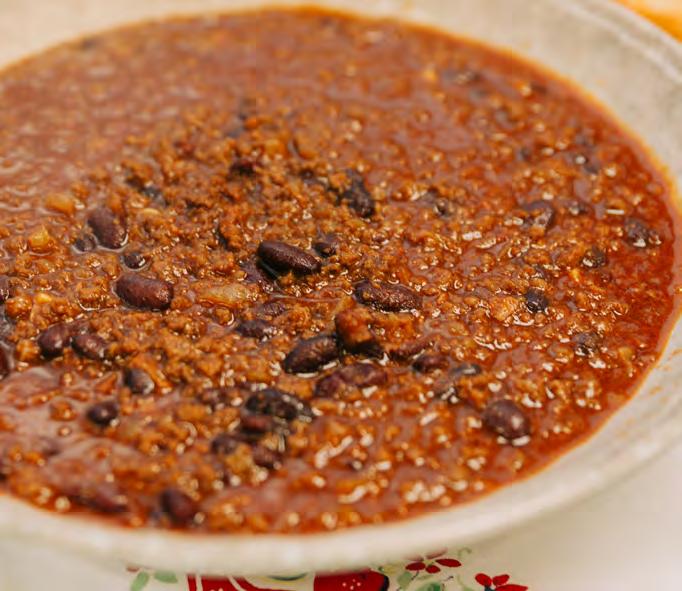
SERVES 20-30
30 slices bacon
8 pounds hamburger or ground chuck
10 small onions, chopped
20 cloves garlic
10 (15-ounce) cans tomato puree
10 (15-ounce) cans kidney beans with juice
15 teaspoons chili powder
20 tablespoons white sugar
30 tablespoons white vinegar
Salt to taste
10 teaspoons cumin
2 cups brown sugar
PHILIP J. DIBLASI LOUISVILLE
“I got this recipe from my Polish grandma. I have no idea where she got it. It can be halved easily for smaller groups.”
1. Cut bacon into small pieces and fry until crispy. Pour off the fat and set aside.
2. Brown the hamburger, onion and garlic and pour off the fat.
3. Pour all the ingredients into a large pot and simmer for 1-2 hours, stirring frequently.
Notes: This recipe freezes well and is better after it has had time to mellow. Do NOT eat this the day it is cooked, as it is much better when it has had time for the flavors to blend in fridge or freezer. It pairs well with cornbread and a Malbec.


Two friends use a hit KET show to trace the route that foods take from the farm to the plate
BY JARRETT VAN METER
meal is a collision of stories. Everything we eat owns a history, often full of people, places and processes. Even for those paying attention to where their food comes from, many of the systems at work can feel far away and impersonal. In their Kentucky Educational Television show The Farmer and The Foodie, Maggie Keith and Lindsey McClave deftly trace the lifespan of Kentucky ingredients from source to plating. As the titular roles suggest, the two friends approach each episode from different perspectives, but it’s what they share that makes the program feel close to home.
• • •
Keith, “The Farmer,” has 30 first cousins on her father’s side. During her childhood in Louisville, the family used every birthday, anniversary and graduation as an opportunity to gather at her grandparents’ home in The Highlands. Upon arrival, Keith and her brothers always made their way down into the basement to play with the cousins while her grandmother and aunts prepared dinner. Anticipation mounted in congruence with the delicious aroma coming from the kitchen. The menu varied, but a hallmark was chuck roast prepared with carrots and potatoes.
Keith remembered the visit when she discovered a stash of chuck roasts in her grandmother’s garage freezer. To that point, she had only seen the final product, the
PHOTOS COURTESY OF KET

alchemic work of her aunts and grandmother, without any thought to where the meal came from. It was a glimpse into her future as the fourth-generation steward of Foxhollow Farm in Crestwood, a role she inherited from her mother’s side of the family.
“Now that I’m in the business of selling freezer beef, pretty much, that memory to me is just so clear that, of course, that’s what you do— you have all your chuck roast in here in case your family comes over,” Keith said.
McClave, “The Foodie,” enjoyed her aha moment during a family vacation in Italy. The 2007 trip was a summit of eating, walking and sensory bliss. Each day, alongside her siblings and parents, McClave strolled the narrow streets of Venice, peering into windows and tasting everything. The Lexington native saw things she’d never seen growing up in Kentucky.
“Every day, we passed this little window that looked into this kitchen, and you could smell all the amazing smells—the garlic and the fish,” McClave remembered. “You could see them back there chopping away and see
this squid that they were getting ink out of, and it blew my mind.”
At the end of the week, the family was able to reserve a table at that kitchen’s accompanying restaurant. They ordered the squid-ink pasta, among other items they had watched being made from the window. The dinner was a culmination, the sort of meal that nourished on every existential level, and they had witnessed it come together.
These full-circle flowcharts are the heart of The Farmer and The Foodie . The program utilizes Keith’s farming acumen and McClave’s cooking talents to tell Kentucky food stories. Each episode typically begins with a site visit to a local food source—whether it be a farm, a fishing lake or an orchard—to learn more about the processes at play in what winds up on our plates. After arming viewers with some agricultural background, the pair takes their bounty to McClave’s kitchen in Louisville. With Keith standing by as a de facto sous

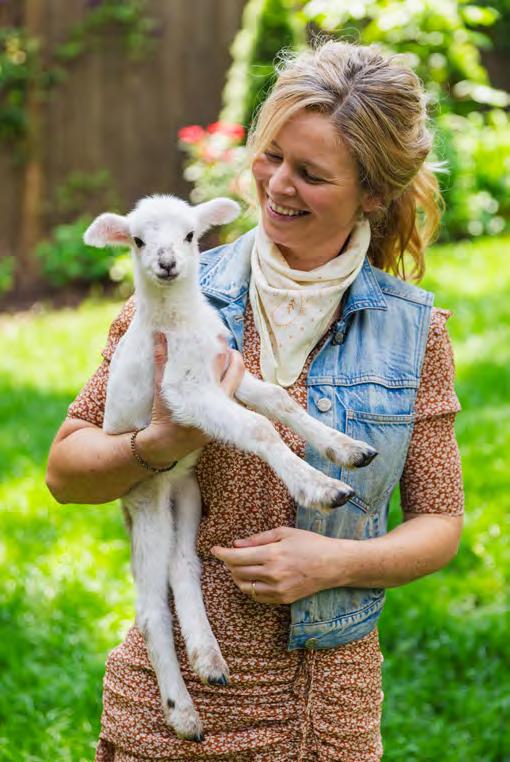
chef, McClave moves through unique recipes developed to highlight the local ingredients.
The pair met through mutual friends in 2009. In the midst of a high-stress career working in the hospitality industry, McClave used cooking as a means of evening decompression. A few miles east in Oldham County, Keith and her mother had recently shifted the operational focus at Foxhollow Farm from the traditional soybeanscorn-wheat troika to biodynamic grass-fed beef.
The connection was natural and easy. The pair bonded over their love of food and curiosity as to how meals are really made. In addition to cooking, McClave also produced a food blog she was writing at the time. She began writing about some of her adventures together with Keith, including the time Keith led her on an expedition for ramps on the Foxhollow property.
“We went out and found these ramps and ate some raw and put some on bread, and we had bottled wine with us. And it was just this lovely afternoon, and I was like, ‘Well, this is fantastic. I feel like I’m in a movie right
now,’ ” McClave remembered.
The friends decided to try a podcast together, then a local radio show in Louisville. Then, they made some homemade promotional videos. From there, with encouragement from Keith’s brother, George, they began workshopping a television show.
Bringing the idea to life took fortitude and resourcefulness. McClave and Keith scrounged up funding to shoot a pilot, using a band of freelancers and a 14-hour day of shooting at Foxhollow to put together the show’s first episode. KET agreed to run it, and The Farmer and The Foodie debuted in August 2016. From there, KET agreed to air—but not fund—an entire first season, so the pair struck out in search of funding.
The fiscal agent for the first season was the Berry Center in New Castle (Henry County), which advocates for small farmers, land-conserving communities and healthy regional communities. In The Farmer and The Foodie, Berry Center Executive Director Mary Berry saw a compelling opportunity.
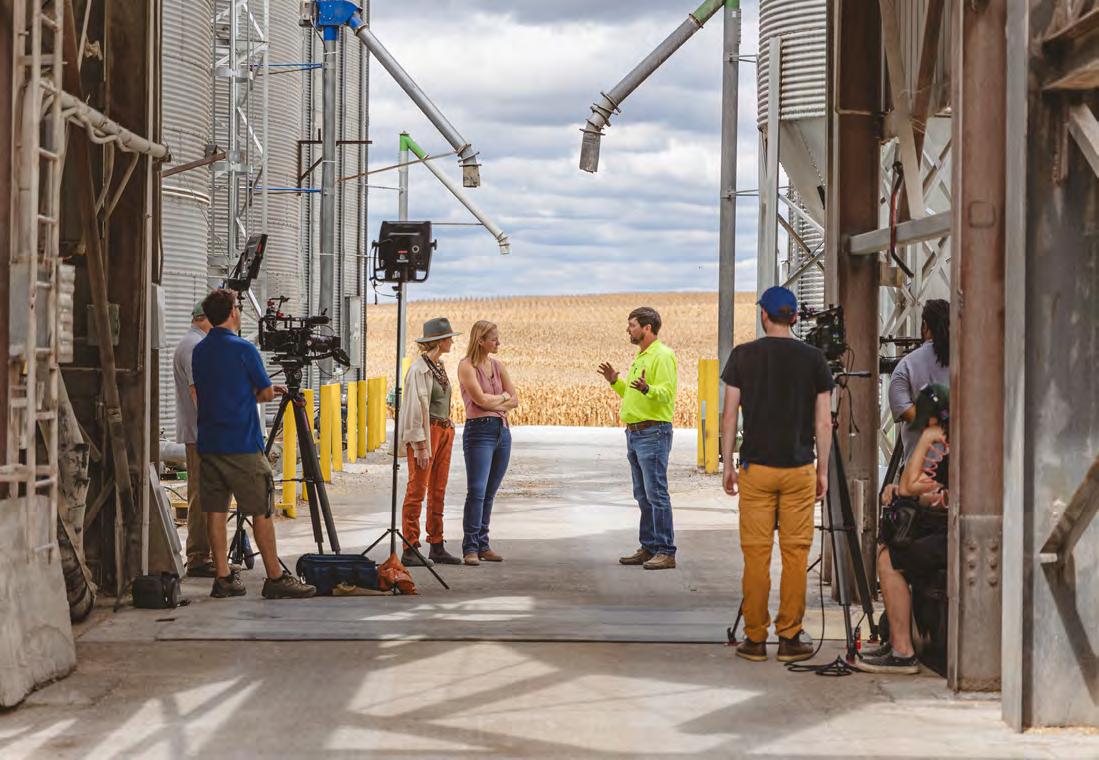
“I think they’re contributing something so important to rural Kentucky, and therefore, rural places everywhere,” Berry said. “Rural places have just been ignored and our raw materials stolen at the lowest possible price, or just outright stolen, for so long now. I think we’re seeing the results of that in the terrible political divide in our country. So, I would go as far as to say that a program like The Farmer and The Foodie really is kind of closing a divide that is, frankly, ruinous.”
Keith and McClave partnered with Kertis Creative in Louisville to put together an entire first season. Among the episodes of the opening season are a trip to Hindman, where McClave’s paternal family is from, and an expedition to Paducah that included carp fishing and a visit with 2025 James Beard Award finalist Sara Bradley, the chef and proprietor of the freight house restaurant. The season was a success, and KET agreed to fully back the next season … then the next four after that. Two Emmy Award nominations later, the show recently began filming its sixth season. Plans are growing in tandem with
the audience, but the mission remains trained on regenerative agriculture, seasonal ingredients, and the connection between people and their food.
“We want to show co-ops, food chains and food systems that are working and make sure that people really understand that there is hope,” Keith said.
On a hot summer morning in 2023, near the mountain town of Whitesburg, the farmer and the foodie found themselves lost.
On their way to a day of shooting, McClave turned her Volvo onto an uphill, single-lane road. The route scaled the side of a mountain. Everything around them was green and lush. Through the trees, they caught occasional views of the undulating Eastern Kentucky landscape. Birds chirped. The sun was shining. It was a beautiful drive.
It was, they soon discovered, the wrong direction.


To keep moving forward was to push farther away from the day’s filming location, but the road was too narrow to turn around. There was only one way down.
“I got out of the car and was trying to coach her through backing down the super windy road,” Keith said.
The pair still carpools around the state in the Volvo. With McClave behind the wheel and Keith in the
Season 5 of The Farmer and The Foodie premiered on Jan. 4. To view the show, check the schedule of your local KET affiliate or catch up on past episodes streaming on KET.org, PBS.org or the free PBS app.
passenger seat taking notes on her laptop, they plot, scheme and dream about the Kentucky stories still left to tell. They bat around questions to ask, recipes to try out, and guests to invite, all of it pouring into a Word document as fast as Keith’s fingers can type. The result is a map of sorts, a shared course forward and in the right direction. Q
Christian County produces mixes that are sold across the country thanks to its abundant wheat production and processing plants
STORY BY LAURA RAY
BY ROBYN PIZZO
Hopkinsville—or “Hoptown,” as it’s known colloquially—is the county seat of Christian County, the largest county by area in Western Kentucky and the second-largest in the state. The county’s sprawling farmlands are home to a huge agricultural community. One of the abundant crops grown in its fertile soils is soft red winter wheat, which is how Hopkinsville became known as the Batter Capital of the World.

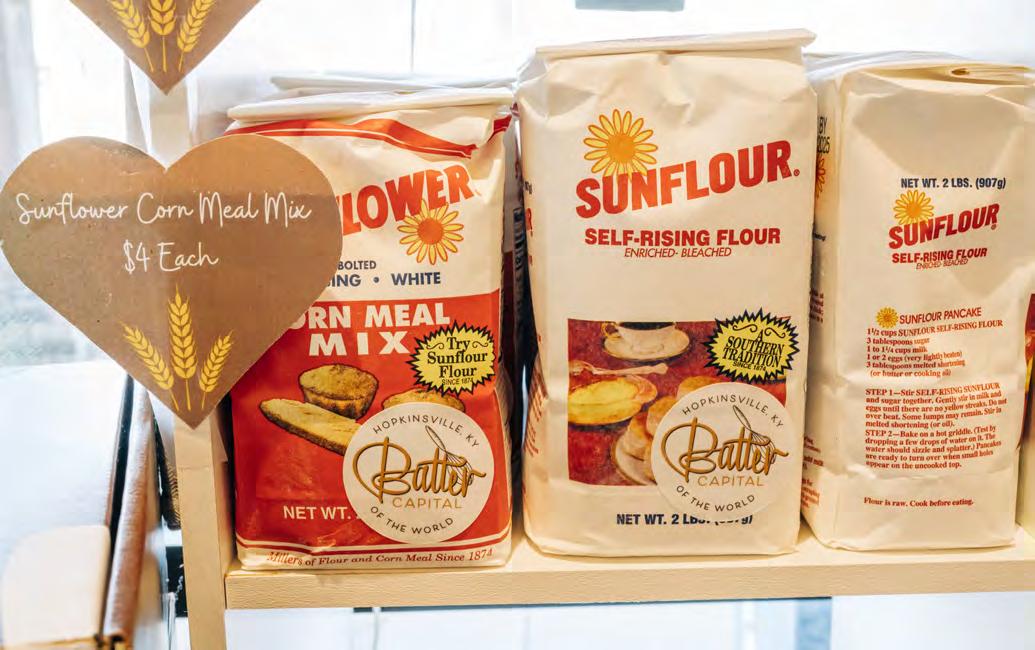
Hey, batter batter! Batter matters in Hopkinsville, but we aren’t taking about the Louisville Sluggers. “Batter,” in this case, refers to the culinary kind used in baking and frying. Delicious treats, from Ghirardelli brownie mix to Red Lobster Cheddar Bay biscuit mix, come out of this Kentucky town. A long history of milling wheat and manufacturing food mixes put Hopkinsville on the map as the Batter Capital of the World and added batter to the mix of other Kentucky culinary delights: burgoo, barbecue and bourbon.
Christian County was founded in 1797, and its first gristmill, where the Hopkinsville Milling Company is located, was built in 1800. A gristmill grinds grain to make flour, cornmeal and grits. Today, Christian County is the leading producer of winter wheat in Kentucky. Soft red winter wheat, a variety primarily grown east of the Mississippi River, is ideal for confections such as cakes, cookies and crackers.
Once harvested, the wheat is sent to the local mills, Hopkinsville Milling Company and Siemer Milling Company, to be processed. Hopkinsville Milling
Company has been producing Sunflour flour, cornmeal and grits since 1906. Every day, Siemer Milling Company produces 2 million pounds of flour to be delivered in bulk quantities to places such as chain hotels and restaurants. All McDonald’s biscuits on this side of the Mississippi are made with flour from here in the Bluegrass State.
Siemer Milling Company delivers 520,000 pounds of its daily flour production directly to The Krusteaz Company through food-grade pipes. Formerly known as Continental Mills, Krusteaz uses the flour to produce more than 450 mixes, including its name-brand muffin, cake, cookie, cornbread and pancake mixes, plus mixes for beloved Red Lobster Cheddar Bay Biscuits and Ghirardelli brownies.
Local restaurants such as The Mixer in historic downtown Hopkinsville also uses the flour. “We actually get all of our flour that we [use to] make everything— every pastry, every dessert, any meals that have flour in them—we get from the local Siemer Milling here in town for free,” Mixer co-owner Heather Dawson told Spectrum News. Siemer donates the flour, helping Dawson show off other local ingredients.
The Batter Capital of the World initiative is the brainchild of Brooke Jung, who applied for a grant through the United States Economic Development Administration

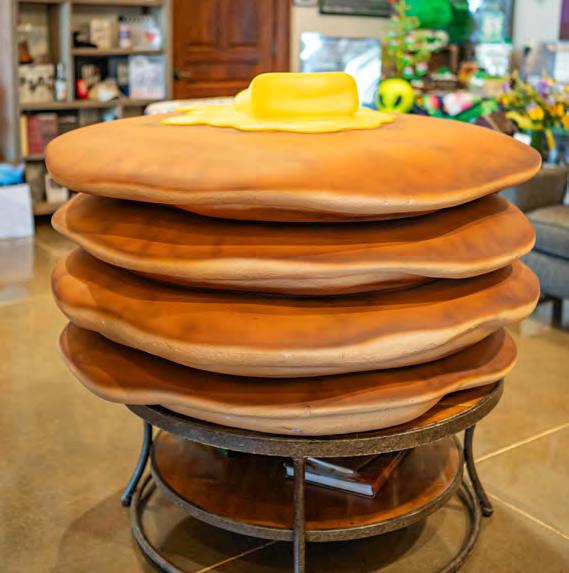
(EDA) when she was the director of the HopkinsvilleChristian County Convention and Visitors Bureau, with the goal of expanding the bureau’s impact across the state and beyond. Visit Hopkinsville was awarded $32,107 of the $5.5 million in EDA funds that were distributed among 103 tourism, destination and marketing organizations in 88 counties across the Commonwealth, according to the Hoptown Chronicle. Much of the funding was earmarked to promote the new moniker.
Christian County wouldn’t be the largest producer of winter wheat in Kentucky, and Hopkinsville couldn’t enjoy this claim to fame, if it weren’t for the farmers, said Amy Rogers, who was named executive director of tourism about a year ago. “Hopkinsville proudly holds the title of ‘Batter Capital of the World!’ This is more than just a tagline; it’s a testament to the incredible work happening here,” Rogers said. “We at Visit Hopkinsville deeply appreciate the partnership with Krusteaz, whose products showcase the quality of our region. And we extend our heartfelt gratitude to our local farmers, whose tireless dedication to cultivating the soft red winter wheat makes it all possible.”
Kentucky ranked as one of the top 15 wheatproducing states in 2023, according to Kentucky Farm Bureau. The USDA’s National Agricultural Statistics Service Kentucky Field Office estimates that Christian County produced a county record-high 6.15 million bushels in 2023, leading the five counties that account
for half the state’s wheat production.
The batter production industry supports hundreds of jobs in Hopkinsville and the surrounding region, from factory workers to agricultural suppliers and distribution roles. As a major manufacturing hub, Hopkinsville is a key player in the U.S. food-manufacturing sector. According to the Hoptown Chronicle, The Kitchen Food Co.—a privately held Australian company that produces ready-made meals—is investing $69 million in a new production facility in Hopkinsville that will employ 925 workers. Beyond the factories, the batter industry is a boon to the local economy, supporting trucking, logistics, packaging and even local restaurants that use these products.
“Being the Batter Capital of the World is something we take pride in here in Christian County,” said Christian County Agri-Business Association President Ryan Milauskas. “Not only does it make Christian County unique, but it also highlights how Christian County and our ag community as a whole continually find ways to improve efficiencies through vertical integration.
“Having consistently strong wheat production, purchasing capabilities, multiple means of transportation, and the processing capacity all right here in Christian County is a huge benefit and advantage for our farmers and our community.” Q
Everything’s better with batter! Learn more about the Batter Capital of the World by exploring these Hopkinsville locales.
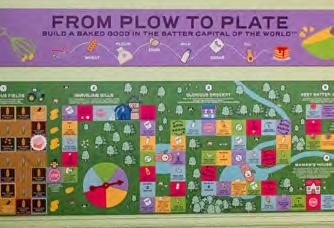
Pennyroyal Area Museum
Built in 1914, the old post office houses the Pennyroyal Area Museum. There, visitors can learn about everything Hopkinsville, from the Kelly Green Men visit and the bizarre bevy of blackbirds that descended upon the city to famous locals such as psychic Edgar Cayce and author bell hooks. An interactive exhibit called “From Plow to Plate” is a Candy Land-style game where kids gather ingredients on their way to Mamaw’s House to bake something sweet.

The 4-foot batter bowl at the Visitors Center isn’t the only photo opportunity in town. Head downtown to get your pic with the 12-foot-tall public art installation of wheat.
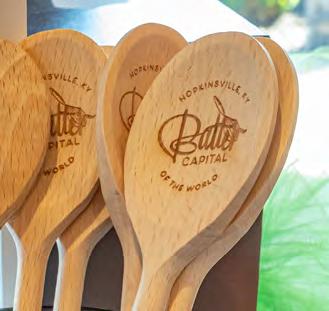
Visit the official Batter Capital gift shop at the Hopkinsville Visitors Center, located at 1730 East 9th Street, to stock up on merch and purchase packages of locally produced items, from pancakes to Sunflour cornmeal. Behold the giant stack of pancakes and get your photo taken in the big bowl of batter!


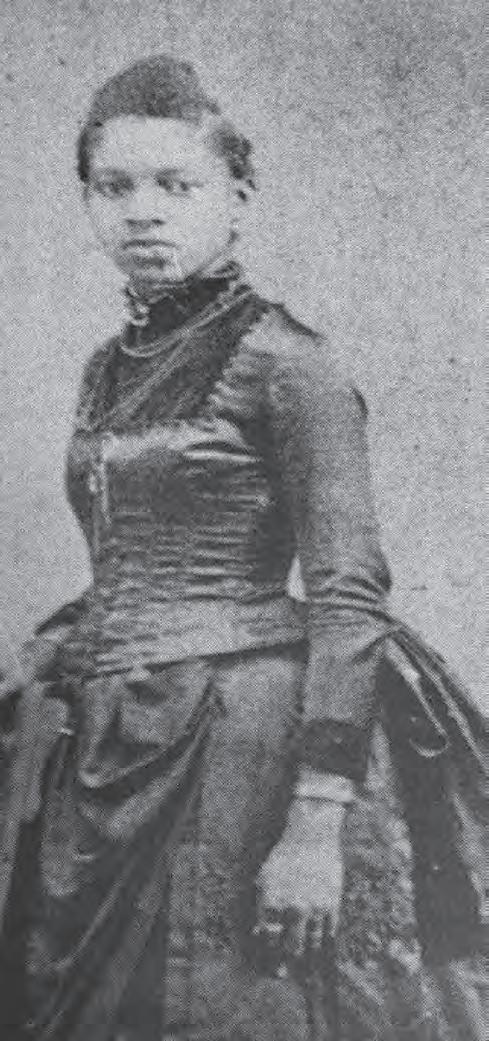


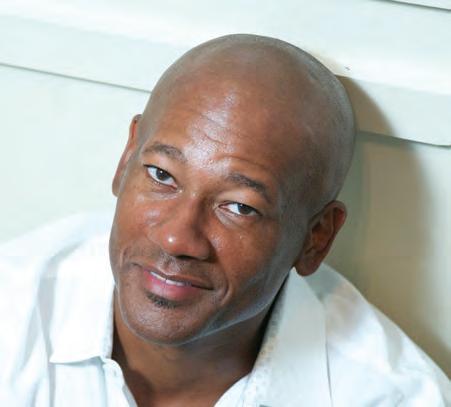

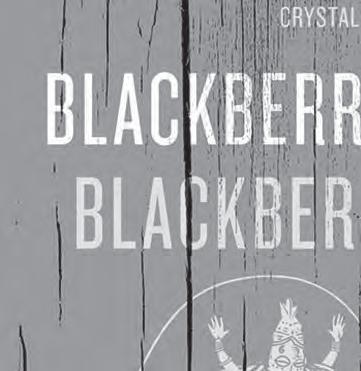



A bad experience inspired a Northern Kentucky entrepreneur to create Kona Ice, a multimillion-dollar business
BY JACK BRAMMER
One late summer day in 2005, Tony Lamb and his family heard the familiar strains of jaunty music from an ice cream truck waft across their residential neighborhood in the Northern Kentucky community of Union.
The kids came a-runnin’. Lamb’s 3-year-old daughter, Ava, knew sweetness awaited. Her little legs swiftly carried her to the truck for a cool concoction.
But Lamb did not like what he saw.
The ice cream truck was a dilapidated Chevy van from the 1970s with blue smoke billowing from its undercarriage. It was driven by a shirtless, tattooed and pierced man who seemed lackadaisical about his mission. Ava was startled. About $22 later for refreshments for his family with nary a thank-you from the driver, the Lambs had popsicles that suffered from freezer burn. The experience was a complete disappointment.
The event changed Lamb, who was making a decent living as a business consultant working out of Louisville
after selling vacuums. He wanted to do better for his wife and three young children and have a job with less traveling. The bad ice cream truck incident led him to a career as founder and owner of a multimillion-dollar shaved-ice franchise business with franchisees in every state except North Dakota.
Kona Ice is its name. The company’s mascot is an animated penguin named Kona. In Hawaiian, “kona” means “dry side” or “lady.”
• • •
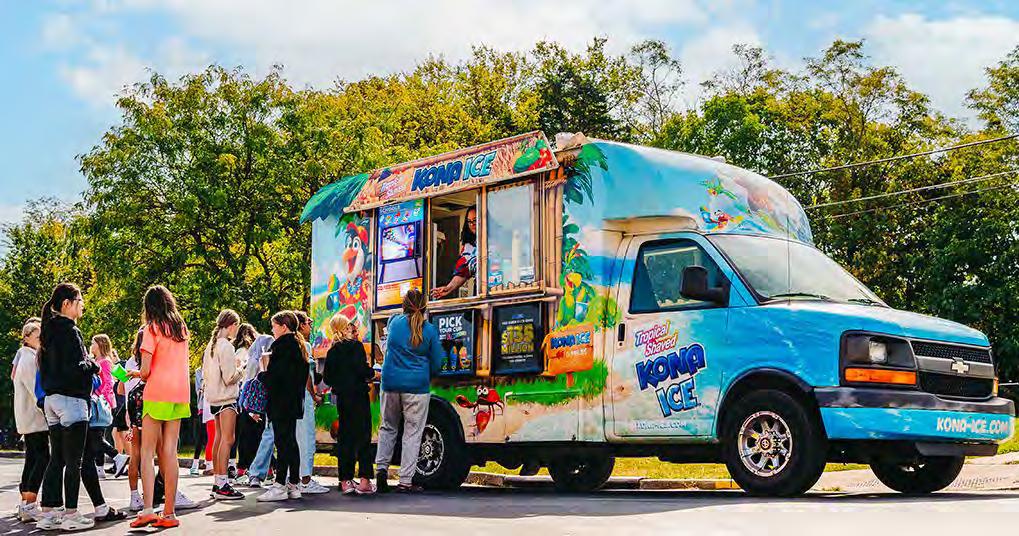

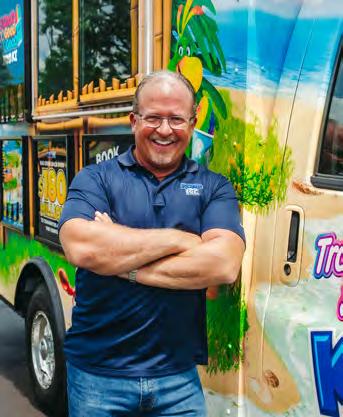

Pick a place where you are most likely to find a most successful shaved-ice business. You might select Waikiki, Jamaica or perhaps the Bahamas? A great guess would be 5945 Centennial Circle in Florence in Northern Kentucky. The 7-acre site a bit down the road from Florence Mall in the heavily developed part of the Boone County community is home to Kona Ice. The business venture became a reality after Lamb went home the evening of the bad ice cream
truck experience and pondered what went wrong.
He became obsessed with the idea that he could provide a better service to sweet-toothed children and adults. “I thought, ‘What if that were my truck?’ ” Lamb said. “First, I would want it to be colorful, like Disney World. I would make sure the product is right, and I would treat every customer right. One thing led to another. I got a loan from an associate, and I got into the shaved-ice business.”
On June 21, 2007, Lamb got his first shaved-ice truck. By the end of the year, he had designed and produced five prototypes.
The business began franchising in 2008. Four years later, the company launched the Kona Mini, a smaller version of the Kona Ice truck, to sell shaved ice indoors during the winter months. The company was recognized in Entrepreneur magazine’s Franchise 500 list in 2013. Today, it has about 30,000 employees and 685

franchisees operating trucks across the United States.
Tony’s wife, Susie, is involved in the shaved-ice company. They married in 1992 and have four children—Jake, 31, who runs a department in Kona Ice Korporate; Annie, 28, a wedding photographer who is married to a Kona Ice employee; Jonah, 24, who runs local operations for Kona Ice; and Ava, 22, who works in Kona Ice’s video department.
The company has donated more than $200 million to communitybased organizations since its foundation. “We are not close to being done,” said Lamb recently in his large office at Kona Ice Korporate. He keeps a teddy bear nearby that he has had for about 50 years. Pull its string, and it says, “There’s nothing you can’t do.”
• • •
Lamb was born Nov. 2, 1968, in Parkersburg, West Virginia, on the 32nd birthday of his father, Tom
Lamb, a former vacuum cleaner executive who now spends every weekday except Fridays at the Kona Ice Korporate offices. The senior Lamb never meets a stranger. He quickly advises husbands to tell their wives every day, “you are the prettiest woman I’ve ever seen” and then tells you how big his son’s heart is for people. Tony said his father encouraged him to be his own boss.
Tony was the youngest of Tom and Beverly Ann Lamb’s four children. He attended Parkersburg High School and the University of Kentucky, where he received a degree in marketing in 1992. During that time, he sold Rainbow vacuum cleaners. In high school, Tony was president of his senior class of 800 students. He played on the football team but was better known for “being funny.” “I was not shy. I sold vacuum cleaners. I could not afford to be shy,” he said.
After graduating from college, Lamb contemplated working as a
pharmaceutical representative for about $31,000 a year but instead decided to be a vacuum cleaner salesman with a decent commission. He stayed with Rainbow until 2002, when he became a marketing consultant for businesses. And then came the summer day with the bad ice cream truck, and his future crystallized into shaved ice.
• •
•
Unlike typical snow cones that can be bought at a county fair, Kona Ice is a gourmet treat. The ice is shaved in patented machines that cost $3,000, and the nearly 40 flavors include exotic choices such as banana colada, bubblegum blue, strawberry daiquiri, wedding cake, tiger’s blood, Creamsicle, rock & roll and watermelon.
Lamb, who acknowledged he may not be the biggest fan of shaved ice, admitted to liking the strawberry flavor of tiger’s blood.

The truck enables customers to customize their purchase through Kona’s patented Flavorwave system, a dispenser built into the side of the truck that lets them choose as many and as much as they want of the 10 most popular flavors.
Kona Ice shaved ice contains 40 percent less sugar than regular sugarwater snow cones and can be made of 100 percent fruit juice in participating locations. “You really can’t tell the difference,” Lamb said about the product containing less sugar.
Franchisees can set their own costs, but the typical local cost is $4 for a Klassic Kup, $5 for a King, $6 for Color
Changing with $4 refills and $7 for a large Kollectable Kup with $4 refills.
A franchise costs $150,000$200,000, including the truck, other essential parts and training. The franchisee can buy ice anywhere.
Kona Ice not only has trucks for franchisees to visit neighborhoods but can be hired to serve parties, corporate events and public gatherings.
In March 2020, Lamb launched Travelin’ Tom’s coffee trucks, named after his dad, and he is experimenting with Beverly Ann’s Cookie and Ice Cream trucks, named after his mother.
He ponders even more ways to use mobile trucks.
In November 2023, Lamb was inducted into the Kentucky Entrepreneur Hall of Fame at a Lexington ceremony. More than 100 of his franchise owners attended the induction.
He said he has many people to thank—his family, his parents, the associate who gave him a loan to start Kona Ice, his franchisees, his employees and, yes, even the driver of the bad ice cream truck.
When asked how he would react if he saw the driver today, Lamb laughed and immediately said, “I’d kiss him right in the mouth and thank him for inspiring me.” Q
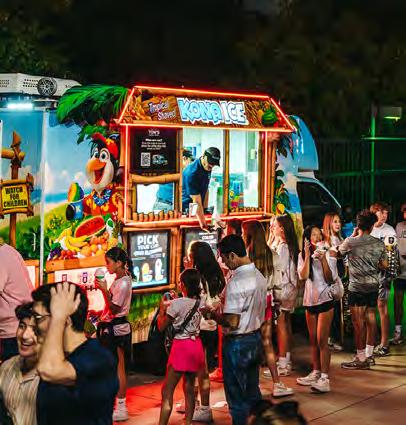
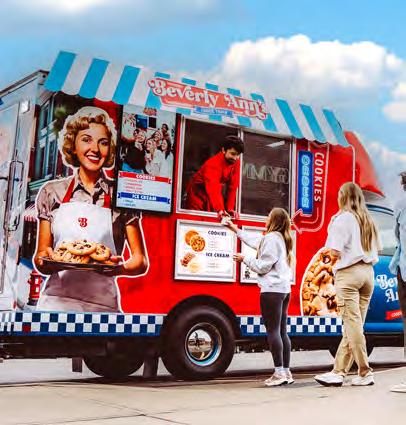
Tony Lamb thinks his idea of mobile coffee trucks may prove better than his successful venture with shaved ice. He’s also contemplating a mobile truck to sell warm cookies and ice cream.
“What we are considering is a total realignment of the mobile food truck for franchises and rentals and what we can do for it,” the innovative Lamb said during a recent interview at his
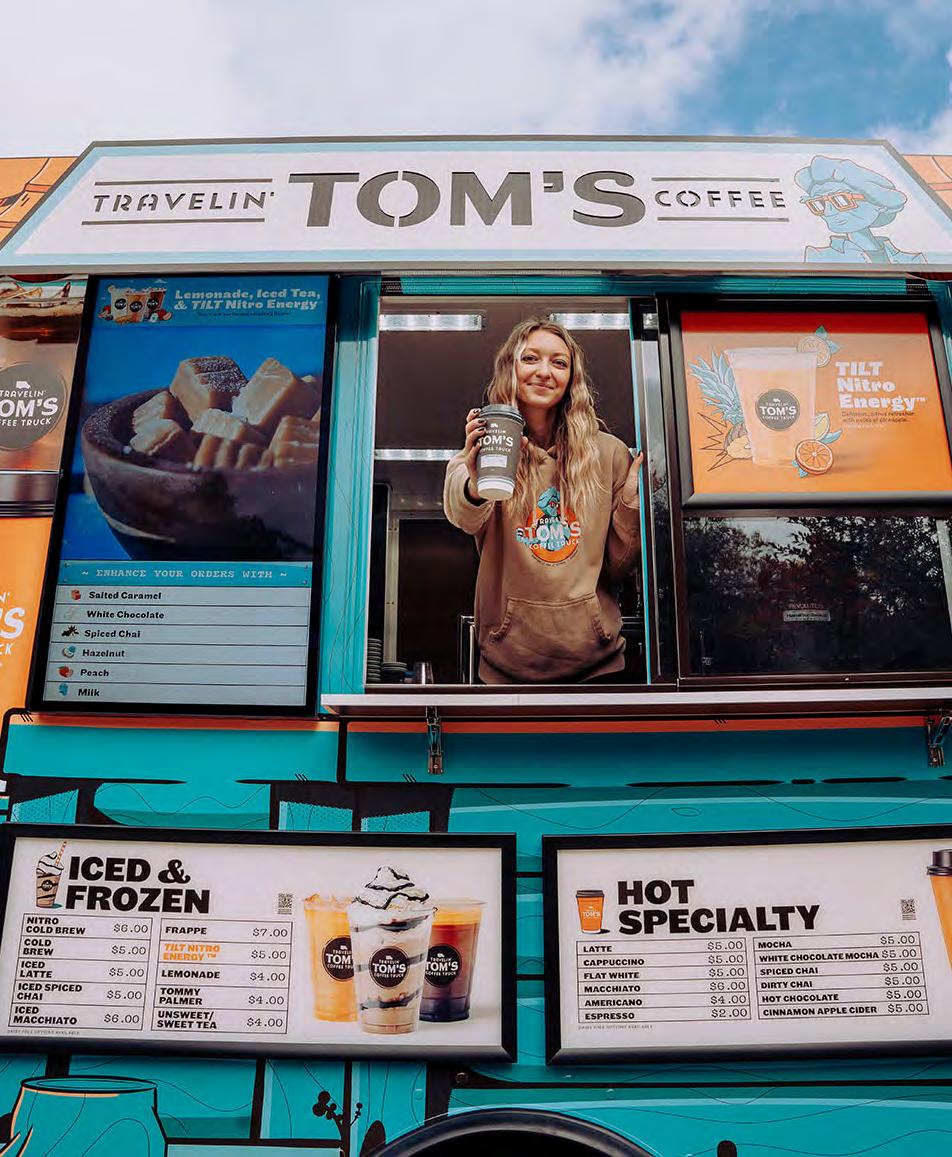
Kona Ice Korporate office in Florence.
“We are doing it for the masses.”
Travelin’ Tom’s Coffee Truck, which is named after Lamb’s father, Tom Lamb, provides hot and cold coffee. It charges $4 to $7 for iced and frozen coffee and $4 to $5 for hot coffee. The coffee is made fresh in the truck.
Beverly Ann’s Cookie and Ice Cream trucks are in the experimental stage for Lamb’s business. On its five trucks are plastered a vibrant picture of his
mother as a pretty young woman.
For its edible pleasantries, the customer has to pay $4 for two cookies (ranging from decadent chocolate chip to premium vanilla extract), $7 for four and $10 for six. The ice cream—vanilla, chocolate or strawberry—costs $3 for one scoop and $5 for two scoops.
An “Ann-Wich,” made up of two cookies and one scoop of ice cream, goes for $6.
Rebecca, George and Seth Romero are passionate about bringing a taste of Italy to Mount Sterling
STORY AND PHOTOS BY ROB BOLSON
Aguy walks into a bar …
Most likely you’ve heard any one of the numerous jokes that begin that way. That is where the true-life story begins of Romero’s, a popular family-owned and -operated upscale Italian eatery and cocktail lounge in downtown Mount Sterling. The restaurant is celebrating its third anniversary in 2025.
In 2014, George C. Romero left Los Angeles, traveling the country, and serendipitously decided to make a stopover in Lexington.
“It was love at first sight,” George noted upon meeting Rebecca, who was working as a bartender in the establishment he visited. “I sat down at the bar and had one drink, and we kept talking and talking. Never got up until they threw me out.”
George was so smitten with her that he “baited her,” leaving behind his ring in hopes that she would reach out to him to return it—and she did. The ploy worked. He not only fell in love with Rebecca, but he also fell in love with Kentucky. The pair later would marry in Mount Sterling. When people ask how long they have been married, they give the same answer: “Not long enough.”
Today, they have two children, two grandchildren and
five rescue dogs.
In addition to co-owning Romero’s with Rebecca, George—a son of the late George A. Romero, the legendary American-Canadian film director, writer, editor and actor and considered by many to be the grandfather of the horror and zombie film genre—is also a producer, director, comics writer and contributor to the futureverse of Heavy Metal magazine. He is also one half of Romero Pictures, along with Rebecca. With almost two dozen films and hundreds of commercial campaigns under his belt, George has written, produced and/or directed and arranged financing for more than 35 film, television and streaming projects and serves as a business consultant and mentor for young and new filmmakers, content creators and entrepreneurs.
He recently became head of the Montgomery County Film Commission and the newly formed Eastern Kentucky Film Commission.
Rebecca is a native of Wolfe County and grew up at the “mouth of the holler.” She is a self-proclaimed “closet artist” and, according to George, “one hell of a singer.” She prefers to sing Fleetwood Mac “and the older stuff.” You may catch her performing at Romero’s during karaoke on Open Mic Night.
• • •
Opposite page (far right): Rebecca and George Romero and Seth Romero (top right) opened upscale eatery Romero’s in August 2022 first as a Cuban restaurant before switching to Italian cuisine a few months later.

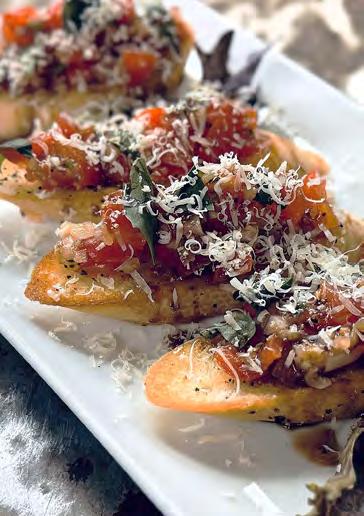
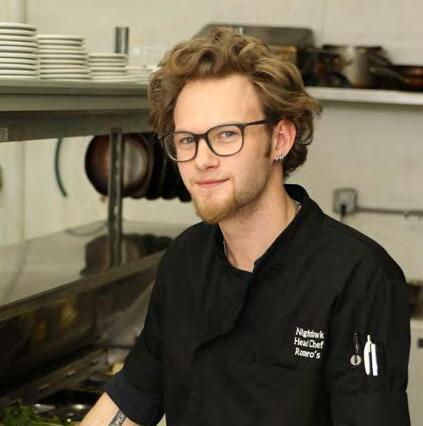


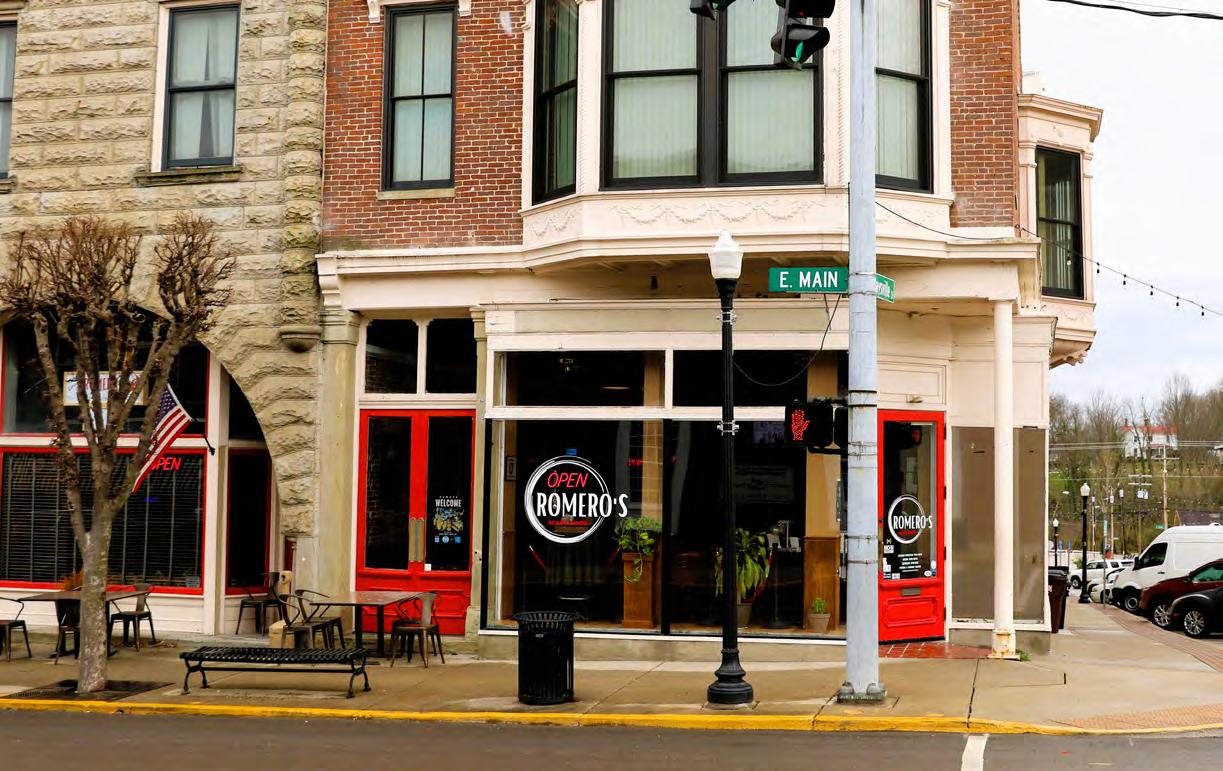
For years, Rebecca and George drove by the current location of Romero’s and ate at the various restaurants that previously occupied the space. In the Romero home, George cooked while teaching their son, Seth, what he had learned over a lifetime of cooking. As the family sat around their dinner table, they would talk about the meal, discussing questions such as: “Is this something we would serve if we ever opened a restaurant?” “Would this be viable to make in large quantities?” and “What would we charge for this in order to be competitive?”
“I don’t think we realized it at the time, but we were planning for an opportunity that God was fixing to place before us,” Rebecca said.
One night, Rebecca and George were dining at the restaurant that occupied the space now known as Romero’s, and George spoke with the owner, who offered to sell the Romeros the business. After long talks with the family and much deliberation, Rebecca, George and Seth decided to take the plunge and do what they had discussed for years. About a week later, George and Rebecca accepted the previous restaurant owner’s offer.
Romero’s opened in August 2022 as a Cuban restaurant for its first few months.
“Then, one day, Becky asked, ‘Why don’t we switch to
Italian?’ ” George recalled. “I said, ‘I’m from Pittsburgh. I do know how to make Italian food.’ ”
Italian food undoubtedly is an American favorite, as many grew up exposed to Italian cuisine at the dinner table. Italian restaurants are a staple of dining out in this country. Italian food showcases simple ingredients. (Who doesn’t love garlic?) As noted on the website VisitItaly.eu, “The greatest ingredient that makes Italian food truly special is its ability to connect people through sharing meals.”
George believes that a proper meal “should tantalize all of the senses and not be something that one rushes through.”
Twenty-year-old Seth, aka Nighthawk, is the head chef. He possesses a passion for food that developed naturally, and his culinary skills come from years of learning from George.
“I started cooking one night at home, and [Seth] just started standing next to me,” George said. “I’ve been training him for the last 10 years, and I’ve tried to train him to be adventurous—to not be afraid to try things that don’t seem to work together.”
Some might question opening an upscale Italian restaurant in a town with a population of 7,558—a world away from Italy—but with its enticing, varied menu items, Romero’s has been well received and frequented by locals,
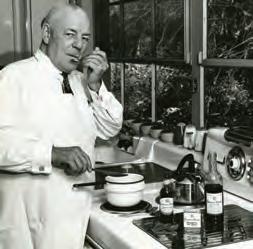
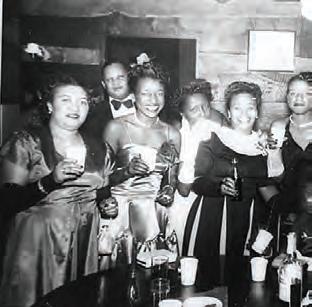
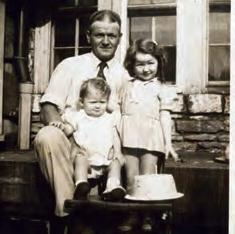
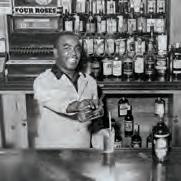

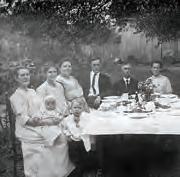



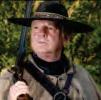









sports figures, actors, politicians and guests traveling from many miles away.
• • •
Romero’s offers an ever-evolving Italian fusion menu that changes as its chef-driven kitchen develops new dishes—an inspired pairing of the freshest, high-quality ingredients and exquisite flavor combinations. The restaurant scores an impressive 4.8 on Facebook, 5/5 on Microsoft’s Bing, 5.0 on Tripadvisor and 5.0 on Yelp.
“Hands down, our salmon dishes are our top sellers. We offer a Smoke and Spice Salmon Pasta and a Lemon Caper Salmon Pasta, and we joke that if we ever took those off the menu, people would come after us,” George said. “Our Chicken Piccata is also top of the charts along with our burger and chicken parm handhelds.
“Our menu offers a diverse and rustic take on many traditional Italian dishes, so we love it when guests tell us they enjoy working their way through our entire menu.”
Starters include Bruschetta, Toasted Meatballs, Parmesan Truffle Fries, The Mozzarella (six “massive” hand-breaded cheese sticks served with house marinara or spicy chorizo dipping sauce) and Arancini (four toasted house-made risotto rice balls filled with cheese and wild mushrooms).
Salad choices start with The House (topped with red onion, cucumber, julienne carrots, cherry tomatoes, and feta or bleu cheese crumbles). Add house-made bruschetta and/or choice of protein (chicken, shrimp or salmon) for an additional charge. Paying tribute to George’s hometown, The Pittsburgh salad is topped with 48-hour marinated steak, hand-cut fries, shredded mozzarella and provolone cheeses, served with house balsamic vinegar and housemade ghost pepper ranch.
Main courses include Italian Drunken Noodles (sweet Italian sausage, garlic, cherry tomatoes, sun-dried tomatoes, kalamata olives and a touch of spice to add some heat), the Smoke & Spice Salmon (served over spicy garlic chipotle pasta), The Bolognese (sweet Italian sausage, regional beef and chorizo red wine sauce served over house pappardelle pasta noodles), The Roman Puttanesca (crushed anchovies, kalamata olives, garlic and capers in a red wine and San Marzano tomato pan sauce) and The Pomodoro (roasted garlic cloves, fresh basil and cherry tomatoes in a white wine pan sauce). Several other pasta options are available, and each is served with an organic side salad and house-made bread.
The Burger is made from a mix of regional beef and chorizo. You can double the beef and/or add an egg. Other sandwich options include The Philly (48-hour marinated steak, green peppers and onions, mozzarella and
provolone), The Wrap (blackened chicken breast, organic spring mix, fresh tomatoes, red onion and cheese in a giant tortilla) and The Parm (hand-breaded and pan-fried and served on a hoagie roll with house-made marinara and melted mozzarella). Each handheld is served with handcut fries. Upgrade to hand-cut onion rings for an additional charge. Desserts change, so check with your server for the day’s dessert offerings.
•
Operating a family-owned restaurant can have its challenges. The 2025 Independent Restaurant Industry Report noted that many independent restaurants are just one emergency away from closing their doors permanently. Romero’s experienced a nearly catastrophic event last October when its refrigerator’s compressor went out. For almost two months, the restaurant had no walk-in cooler and no keg cooler.
“We were completely down the first two weeks but then we managed to reopen,” George recalled. “We went to the grocery store almost daily. We ran a limited menu.”
“It happened on a Sunday, in the middle of Mount Sterling’s annual Court Days Festival,” Rebecca said. “We lost a lot of customers, but we didn’t give up.”
With a small staff, it is all hands on deck to keep the business running smoothly. “We both will bus tables, bartend, run food, wash dishes … You have to,” George said.
Many events take place at Romero’s, including a Women in Business Networking event on the first Tuesday of each month. Tuesdays also are ‘Teachers Tuesdays”; Wednesdays are “Wine-Down Wednesdays”; and Open Mic Night is on Thursdays.
The Romeros are considering opening a second location “in a popular place,” but no formal plans are in the works.
Rebecca is quick to point out that operating the restaurant has allowed the Romero family to meet some “really great people” whom they consider to be like family, and they continue to fully embrace the many challenges of successfully operating an independent restaurant.
“It is all worth it when we stand in the dining room full of guests and watch our servers deliver food to their tables, then see their eyes light up and their phones come out to take photos. And they share bites of their dishes with others at their table to looks of amazement,” Rebecca said. “It’s a feeling unlike anything we have ever felt before.”
“We wake up every day with grace and gratitude and love in our heart, George said. “We are not going anywhere. There is not a day we thought about giving up. We are here to stay.” Q

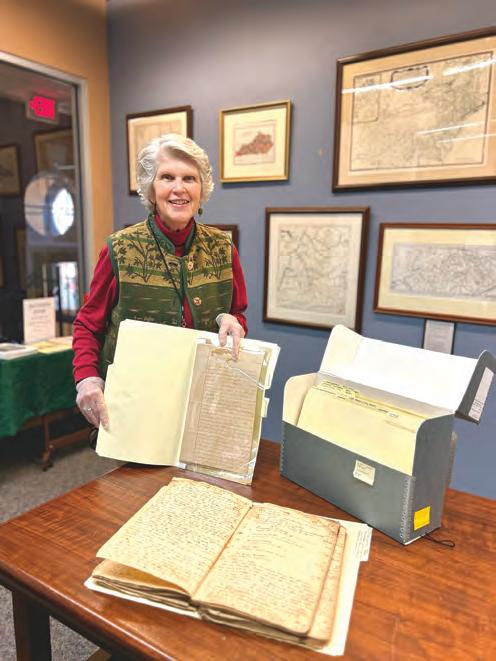





The Whitesburg music festival Seedtime on the Cumberland features a mix of regional cultures
BY KIM KOBERSMITH

91 Madison Avenue Whitesburg
Friday, June 6 evening Punk Show, time TBD
Saturday, June 7 main stage shows on the hour from 10 a.m. to 7 p.m.
For more information, visit appalshop.org/seedtime, RSVP at the Seedtime on the Cumberland Facebook Event page, or contact seedtime@appalshop.org.
Everyone is invited to join the merry band of music lovers making the pilgrimage to the Seedtime on the Cumberland festival June 6-7. Held in downtown Whitesburg by regional cultural nonprofit Appalshop, the free event features local artisans, food and performance art. Music, though, is the main attraction, with an evening Punk Show on Friday and a full main-stage
lineup on Saturday.
The schedule of events includes an eclectic mix of music and performances. Traditional regional music will be well-represented. John Haywood is a repeat performer and a Whitesburg local who teaches banjo to kids and plays all kinds of music. Grace Rogers is a banjo player and songwriter who grew up in the Eastern Kentucky traditional music community. She will perform her
justice-fueled folk tunes. Sarah Kate Morgan is widely respected as one of the leading experts on the Appalachian dulcimer, which she has played since she was 7 years old. While bluegrass tunes and old-time music are the bedrock of the festival, the musical genres have broadened throughout the years to include gospel, hip-hop and punk. This year, a gamelan ensemble will play. This folk style, with roots in Indonesia, weaves
complex, interrelated melodies and harmonies using xylophones, flutes and stringed instruments.
An addition to the celebration is a parade, this year led by The Knox Honkers & Bangers, a self-described “raucous, hot pink, inclusive community marching band” from Knoxville. Attendance at the Seedtime fest has been rebuilding since the COVID-19 pandemic and 2022 floods. Last year, around 300 people came out for the event, a mix of locals and visitors from surrounding states and even other countries. It serves as a homecoming of sorts when former Appalshop employees and volunteers return to the home ground to reconnect and reminisce.
“There are ways for people to get integrated very quickly, like at the jam session tent on the grounds,” said Tucker Leighty-Phillips,
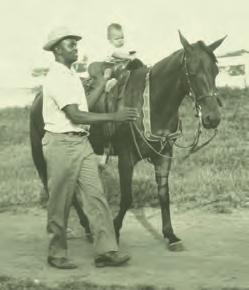
Appalshop’s publicity manager. “As a small regional music festival, Seedtime carries a lot of Southern charm with it, and attendees really want to know each other’s stories.”
Back in 1987, leaders at WMMT radio in Whitesburg envisioned Seedtime on the Cumberland as an annual event portraying the depth and richness of Eastern Kentucky heritage and passing it on to new generations. The title references a nonfiction book by Harriette Simpson Arnow detailing the everyday lives of early settlers in Kentucky and Tennessee. First held in Appalshop’s theater, then in a big tent, the festival now has a permanent home under the organization’s solarpowered pavilion.
Historically, performers included

master musicians and the young artists who learned from them, featuring those who defined regional heritage such as Ray Hicks, Etta Baker and Wade Mainer. The event always has reflected a mix of cultures, recognizing the foundational ways indigenous music and African music have influenced regional styles. Even as musical genres have expanded more recently, the festival has remained a celebration of place-based arts and culture. More recent performers have included Amethyst Kiah, Coaltown Dixie, the Heavenly Voices and Appalachiatari.
Carla Gover—a musician, flatfoot dancer, and songwriter—grew up in Whitesburg attending Seedtime on the Cumberland. It had a profound influence on her, exposing her to a cultural richness that transcended her Eastern Kentucky home.

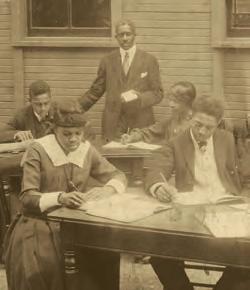

Appalshop’s new WMMT 88.7 studio, just down the road from the main stage at 253A Main Street, will host an interactive visual and audio art show during the festival. The previous studio was destroyed in the 2022 floods. The station has operated out of a modified recreational vehicle on a temporary basis for more than three years, staying on the air during a crucial time. The new, permanent location has a communal exhibit and gathering space that will present the display.
To see previous Seedtime performances online:
Walker Calhoun, Cherokee singer/ banjoist of Qualla, North Carolina, 1993, Beaver Hunter’s Dance, youtube.com/ watch?v=DCuJscgRJ9I&t=1s
Etta Baker, 1997, African-American guitarist, “Never Let Your Deal Go Down,” youtube.com/ watch?v=0KH-hp8uMcg
Morgan Sexton, 1993, banjo/singer, “Little Birdie,” youtube.com/ watch?v=SjZI12xFDOM&t=2s

Alongside plays by the Roadside Theater in her regional dialect were artists from the Zuni tribe, Cherokee singers and a Southern African-American theater group from Georgia.
“Seedtime became especially important to me as a teen, when I was getting serious about pursuing Appalachian music as my career,” she wrote in an email. “It helped me see that what had been the source of stigma and shame could be the source of what made my music unique. And indeed, the banjo and ballads I learned in Eastern Kentucky and at Seedtime have been my ticket to festivals around the world as well as an over 30-year career in music.”
While it has a local focus, Appalshop ensures Seedtime performers have a national and international platform for their work. Festival performances are broadcast live on WMMT 88.7 FM to audiences in four Appalachian states and conveyed to the world online. They have provided material for two national radio series. Banjoist and singer Morgan Sexton, after performing at Seedtime, recorded an album on Appalshop’s June Appal record label and starred in a documentary.
While some performers have been world renowned for their craft, others have a smaller reach just in their own communities. They are chosen based not on their commercial success but on their importance to regional culture. Organizers prioritize inviting up-and-coming local and regional artists, especially for the punk show, motivating young musicians and creating performance opportunities for them.
“We try not to use Seedtime to define the regional arts scene, but instead, the regional arts scene defines what happens at Seedtime,” Leighty-Phillips said. “We want to be on the front lines of showcasing alternative perspectives of Appalachia and keep an open mind about what regional art looks like. Seedtime has lasted almost 40 years because it is constantly evolving and offering something new.” Q
The 1901 Kentucky Derby was the 27th running of the Kentucky Derby. The race took place on April 29, 1901.

In 1917, the U.S. Coal & Coke Company, a branch of U.S. Steel, established the Harlan County community of Lynch, which became the largest coal camp in the world at the time. It was constructed on a portion of the 19,000 acres the company acquired in the southeastern part of the county, close to the Virginia state line. By the 1940s, the population was nearly 10,000, and there were 1,000 company-owned structures in the town. In the 1950s, the town incorporated as a fifth-class city. According to the 2020 census, the city population was 658.
Charles Hayes Jr. • Founder
Stephen M. Vest • Publisher
Deborah Kohl Kremer • Editor
Rebecca Redding • Typographist
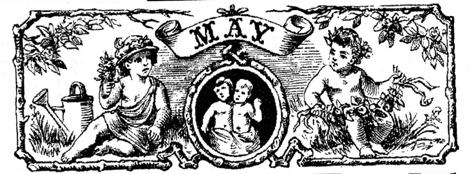
FOUNDED 1986, VOLUME 40, NO. 4
One-Year Subscription to Kentucky Monthly: $25 In memory of Donna Jean Hayes, 1948-2019 Kentucky Explorer appears inside each issue of Kentucky Monthly magazine. Subscriptions can be purchased online at shopkentuckymonthly.com or by calling 1.888.329.0053.
Letters may be edited for clarification and brevity.
The land that eventually became Kentucky had prehistoric people, Native Americans and many immigrants from Europe and elsewhere. It has provided the basic needs of many for centuries. European settlers and governmental policies displaced the “Indians.” Amazing natural and human resources enabled successes and failures. Many were isolated with limited education, communication, transportation and medical care. Numerous people survived their circumstances and thrived here and elsewhere.
Many who were important in and for Kentucky were born elsewhere or before the Commonwealth of Kentucky became a reality. Daniel Boone, Simon Kenton, George Rogers Clark and William Whitley are examples. Adolph Rupp and Harland Sanders and other interesting characters chose to live in Kentucky for much of their lives. Boone and Kenton were early explorers and managed to “own” much land. Boone led the group that axed the Wilderness Road into a narrow trail. He was unsuccessful in winning the bid to widen the Wilderness Road from the Cumberland Gap to Crab Orchard. Boone and Kenton failed to properly record their real estate and eventually lost it. The disgruntled Boone and his wife, Rebecca, chose to move to rural Missouri to live and be buried there. Afterward, Kentucky leaders moved their bodies to Frankfort.
Kenton moved to Ohio. Clark spent much of his own money in battles, but lost documentation hindered his being reimbursed by Virginia. His records were found in Richmond, Virginia, in 1913 long after he had died penniless. Legends and heroes are not always treated kindly.
Whitley built the first brick house in Kentucky. My
mother played in it as a child in Lincoln County. She said that stains on the third floor were believed to be blood. In a recent guided tour, the third floor was closed. Old U.S. 150 was close to the Whitley home, but the new road isn’t.
Colonel Sanders, an Indiana native, lived much of his life in Kentucky. He chose Corbin for his restaurant, motel and gasoline businesses, which thrived along U.S. 25 connecting the north to Cumberland Falls, Florida and more destinations. When he realized that I-75 would bypass his town, he started franchising his Kentucky Fried Chicken when he was about 65. His restaurant in Corbin is practically a museum. His burial site at Cave Hill Cemetery in Louisville is prominent and often visited.
Kentucky is the birthplace of many musicians, including Bill Monroe, Rosemary Cloney, the Everly Brothers, Loretta Lynn, and Billy Ray Cyrus. Rockcastle County’s Renfro Valley has a Kentucky Music Hall of Fame and has provided a venue of country music for many years. Some of us remember Ole Joe Clark. The Country Music Highway in Eastern Kentucky (U.S. 23) commemorates many country musicians.
Shakers, feudists, moonshiners, stereotyped residents, survivors and thrivers are among the many interesting people of Kentucky. You could add many to the list.
John G. Fee, an abolitionist, founded Berea College in the 1800s. Its mission of providing valuable, inexpensive education for low-income Appalachians of all races has been emphasized. Its popular Boone Tavern does not serve alcoholic beverages.
As a Civil War border state, Kentucky people had many challenges. Both Civil War presidents (Abraham Lincoln and Jefferson Davis) were born in Kentucky. Ownership of slaves was prominent in Kentucky for many years.
Cassius Clay (Muhammad Ali) was an amazing boxer and a strong person. He accepted much criticism, fought hard and became perhaps the best known Kentucky native worldwide.
The Great Depression and other challenging circumstances before and after impacted Kentuckians and others. Scarcity of food, shelter, education, transportation, and medical care necessitated hard work, toughness, persistence and often independence. Feuding, moonshining, bartering and other activities could be understood, as family leaders tried to survive and provide for their families. Tobacco was the financial backbone of many rural families and businesses for decades.
Large families and limited industry in rural counties caused many to move to other states and larger cities to find employment. An ingrained work ethic, honesty and humanness helped many to thrive in Kentucky and
elsewhere. Improved education, health care, transportation and technologies enabled tremendous benefits such as easier lives often not appreciated.
No one chose Kentucky to be their native state, but in my admittedly biased opinion, Kentucky is a great and beautiful state in which to live and/or remember having done so. We should appreciate our ancestors and others for their work and sacrifices. Truly, we take much for granted. Why not write about the importance of Kentucky and your ancestors to you?
Harold Brown, a former Lincoln County farm boy now living in Indianapolis and Leesburg, Florida
By Belinda Slone Elliott, Elyria, Ohio
If you ask my mother, she’ll tell you that I was not much good with a hoe. I never hoed more’n a row or two before I’d find an excuse to quit ’n’ go! But there was one time, special indeed, when I hoed for what seemed like an hour. ’Cause, you see, my grandma said she had a need for a young’un with plenty o’ power. My mother didn’t know what would do the trick to get me into the garden to stay … you see, It took a breakfast of biscuits ’n’ gravy, real thick, and, “You can wear MY shoes ’n’ be just like ME!” So, early that mornin’ with the rooster and the dew, we tiptoed ’round gettin’ dressed in the dark; She put on her apron and bonnet … and I did too, but her shoes for the garden were the real mark Of bona fide, certified, country garden girls! They were very plain and black and sort of squatty, And the heels were thick … but oh, what pearls! Wearin’ those shoes, I couldn’t think of bein’ naughty. We trudged to the garden with hoes o’er our shoulders, and she pointed out the rows needin’ hoein’, “Show me what to do ’bout clumps ’n’ boulders ’cause I can’t be a good helper without even knowin’ Which are the weeds and which are your beans and which are the tomatoes you set out.” She chuckled as she showed me the weeds and the beans and how to bust the clumps to get ’em out. I took to my job like a real professional, and I hoed, and I chopped, and it was bliss! And like Grandma knew, if I didn’t catch ’em all, she came behind me and did what I missed. We worked and talked of the good times we’d had, and before long, in the closeness of the rows, Our hoes clicked together, as we hit the same clod. She said, “We’ll hoe again in heaven, God knows!”
My grandma is gone and I’m a grandma now too, and surprised to discover I love gardening as she did, But my grandkids are city kids who wear fancy shoes, so I hoe my garden, and remember being a kid. But I know she planted more than tomatoes and stuff ’cause I’ve reaped so much more than she sowed, Like kindness and grace and mercy and love in my garden … that doesn’t need hoed.
This poem was written in memory of my dear grandma, Nora Ellen Boleyn Slone, whom we called “mom-mom” and whose prayers have busted up a lot of clumps in my garden of life.
This was a true experience with her in the 1950s, when I was about 6 and spent time alone with her in Knott County at Raven on Caney Fork. Clicking our hoes together by accident, she said, “That means we will hoe together again,” but we never did. I expect we will do some gardening in heaven.

Send memories to Deborah Kohl Kremer at deb@kentuckymonthly.com or mail
Frankfort, KY 40602.
By Carol Ingle, Scott County
Where I lived in Wayne County, we celebrated Decoration Day at the end of May. My granny, aunts and cousins got together the week or weekend before and brought all our plastic flowers, styrofoam and vases. We put contact paper on coffee cans to make decorations. Everyone brought everything they had to make wreaths and saddles for tombstones.
Back then, we didn’t have dollar stores from which to get our decorations. We went to the Ben Franklin after the holiday and stocked up on the stuff on sale.
covered dishes. We put them all together and ate after the blessing.
We decorated the graves. Different people stopped at graves and reminisced about the person buried there. We cleaned up the place spotless and collected up our dishes and everything before we left.

On Decoration Day, we cooked all kinds of food—from fried chicken to chocolate pie—and loaded it up to go to the graveyard. My kinfolk are buried in Cabell.
Everybody who has kin in that graveyard brought
By Peggy Patterson Mull, Louisville
As a 10-year-old, I frequently prepared meals for myself, my brother and my sister. I don’t know where my father was, but my mother was working. This was in the 1940s, and without electricity or running water, preparing meals ahead of time for a family just didn’t work.
Dried pinto beans were bought, on credit, from a store in a nearby town. My mother told me I should put two cups of the beans in a four-quart kettle and left them to soak overnight and all the next day. The next evening when I got home from school, I was to put a large spoonful of bacon grease or a lump of lard from the three-pound lard bucket (also a store purchase) with a couple of pinches of salt, cover with water, and bring to a boil on the wood-burning cookstove. The beans had to cook several hours until almost all the liquid was boiled down to make a kind of soupy mixture. Then salt could be added again, if needed.
I remember different ladies holding up a dish and asking who brought it, because they wanted the recipe. Some ladies had slips of paper ready to share. Some would not tell you their recipes. I remember ladies standing around trying to guess what the ingredients were. They took bites and started rattling off what they tasted. It was like a wine tasting.
If someone said, “You put your foot in that dish,” it was a compliment.
I have not been to the graveyard in years, but in my mind, I go back there and see all the people I used to see. I say a prayer for many of them who are buried there now.
and sliced, then put into a cast-iron skillet with another large spoonful of grease or lard and fried. You had to turn the potatoes over often, so they did not burn, yet cook them long enough to be done. If we were fortunate enough to have an onion, it could be added to the potatoes. Salt and pepper to taste could be added at the end.

To make cornbread, you needed ground cornmeal, baking powder, baking soda, salt and either melted grease (bacon grease was best) or melted lard. All this was mixed together and put into a greased iron skillet and put in the oven of the cookstove. The oven was under the top of the stove, with a door in one side. Depending on how hot the stove was, the cornbread could be done in 20 minutes or less. If it was too hot, the bottom and top could be burned but the inside still mushy. Not hot enough and it seemed like forever before it was done. You learned by experience how long to leave it in the oven because there were no temperature settings or timers then.
While the beans were cooking, potatoes were peeled
Sometimes none of this tasted quite right, nor could I ever get all three items to come out ready to eat at the same time, but at least we didn’t starve.
By P.K. Compton, Lexington
I found out early in school what it was like to lose your marbles. I also learned about knuckling down and playing for keeps, all from marbles. It was 1956, and I was in the first grade at Mullins School in Pike County. Mullins was always full of excitement, with fall carnivals, reading festivals, sock hops and basketball games.
The main attraction was the playground. About 50 by 50 yards, it was a paradise of dirt and holes. Teachers monitored the seesaws but not the rest of the playground, which made it perfect for tag, red rover, wrestling and playing marbles. We judged wealth by the quantity and quality of our marbles. We had aggies, cat’s eyes and steelies. Aggies were opaque with colorful scrolling bands, cat’s eyes had crystal transparency with multicolored centers, and steelies were marble-sized ball bearings. Aggies were comparable to pennies, cat’s eyes were like dimes, and steelies like gold. The game, as you might know, involved drawing a circle in the dirt with players taking turns trying to knock out the center marbles with their shooter marble. Before a game began, you stated the rules, such as how many marbles were up for grabs and whether to play for keeps or funzies, which determined if you kept the marbles you won. One rare rule, “stomps,” also called “elephant stomps,” meant that a player could literally stomp on an opponent’s marble, rendering it virtually impossible to hit.
two steelies and four aggies against your one steelie and two of your aggies.” I couldn’t turn back at that point because anyone who didn’t go along with those terms was just plain chicken. I had to agree to a game with a guy who had the disposition of a pit bull.
Brian took a stick and drew the circle in the dirt, purposefully larger than usual. “We’re playing for keeps,” he bellowed. “No quitsies and any shooter marble that doesn’t clear the ring is up for grabs.” I couldn’t argue because he was putting in twice the marbles, even though I felt he would win all of them, including my prized steelie. Then, Tommy said, “You drew the ring and made the rules, Brian, so PK should get the first shot.” He was trying to give me the advantage of clearing two or three marbles up front. “Yeah, go ahead and shoot,” Brian said, confident that I couldn’t knock his steelie out of the ring. I knuckled down and aimed for the edge of the pack, avoiding the middle bunch that might stop my shooter from clearing the ring. My shot knocked two aggies from the circle. My next shot missed, and Brian stepped up for his turn.
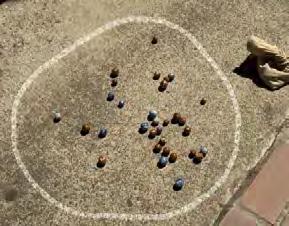

I played for funzies, because my buddies and I just liked the joy of playing. There were a few kids, though, who were always looking to add to their treasure. Brian, the class bully, was a fair marble shooter and always tweaked the rules in his favor. We couldn’t argue with him once he got involved, so we knew the best thing was to stay clear of Brian. I certainly followed that rule but, nevertheless, found myself in a sticky situation one afternoon on the playground. I had my usual six aggies and two cat’s eyes in my pocket and was showing my prized steelie to my buddy, Tommy. He was marveling at its flawlessness when I suddenly realized that Brian was behind us, marveling at it, too. Before I could pocket it and walk away, Brian said, “Let’s play for your steelie.” Tommy knew that I didn’t play for keeps, but now there were other kids gathering, and I suddenly found myself saying, “Do you have a steelie to play against it?” I immediately regretted saying it because he quickly answered, “Sure I do.” Then he added, “I’ll put in
One by one, he ran the ring on me, and I watched as he pocketed the remaining aggies and his two steelies. All that was left was an easy shot to claim my prized steelie. As he took aim, I noticed Tommy looking at me and making a funny kicking motion with his foot. I gave him a quizzical look back, and he did it again as if trying to tell me something. Then it hit me, and before I lost my nerve, I yelled, “Stomp!” and quickly jumped on the steely with my right heel, driving it into the dirt. Brian looked up and said, “Huh?” With my voice cracking, I said “I c-c-call s-s-stomps,” fearing what might happen next. “You can’t call stomps!” he yelled. Then, he was on his feet, and we had already taken a couple of steps back. “Yes, he can,” Tommy injected. “You made the rules and didn’t say no stomps.”
At that point, Brian was stammering and sputtering and was about to erupt, when a big sixth grader walked up. He looked at Brian and said, “That’s right. If you didn’t call ‘no stomps,’ then he can stomp.” By this time, more guys had gathered, and then we heard the bell ring for afternoon classes. Brian glared at me and said “Keep your dang steelie!” and as he trudged away, he stomped it again, grinding it to China, I thought. While the kids were heading back to class, Tommy took out his pocketknife and dug it out for me.
As we returned to school, I thanked my good luck. Not only did I break even on my pennies, but I managed to keep my gold.
By Bob Thompson, Mason, Ohio
The 1893 Chicago World’s Columbian Exposition was a landmark event in American history and culture. Named in honor of Christopher Columbus, the fair was a means of celebrating the 400th anniversary of Columbus’ discovery of the New World and progress of man in science, industry and culture since that historic event. Instead of opening in 1892 (the actual anniversary), the fair opened one year later. It ran for six months from May 1-Oct. 31, 1893.
Countries from all over the world were represented at the fair. It was immensely popular and drew more than 27 million visitors. It was widely publicized, both nationally and internationally, and people traveled from all over the world to see the spectacle. The entrance admission was a steep 50 cents, about $12 in today’s American dollar. Visitors were so desperate to visit this once-in-a-lifetime event that they mortgaged their homes. The admission covered almost all the major exhibits in the fair except for some of the many special exhibits such the reproduction of Kentucky’s Mammoth Cave, which required an additional 10 cents to visit.
furnished with easy chairs, sofas, etc., so that both ladies and gentlemen from Kentucky who may be tired and desire to find a quiet place for rest can be accommodated here.”
The construction of the Kentucky Building was not finished until the end of May, a month after the opening of the fair. June 1 was chosen for the dedication of the building, as it was the 101th anniversary of Kentucky’s admission to the Union.

Various countries brought trade items as bragging items to show off their unique natural resources. It was the first time many people had seen items from another country, not to mention artifacts from different continents. The fair was a trade show, art gallery, lecture series and museum exhibit rolled into one. Nearly every item was for sale.
The state of Kentucky was represented at the fair with the construction of the Kentucky Building and by several exhibits in other exposition buildings. The two-story Kentucky Building was a typical representation of a Southern mansion. In front of the building was a statue of Daniel Boone by Louisville sculptor Enid Yandell that was donated by The Filson Club.
According to the Louisville Courier-Journal: “The chief purpose for which the Kentucky Building has been planned is to provide a comfortable place where the residents of this State can meet for any desired purpose, and where they will be surrounded by an atmosphere home-like and cordial. The house will be comfortably
The Kentucky Building entranceway led into a central rotunda, where there was a life-size reproduction of a statue of Henry Clay directly under the skylight. The bronze-cast statue was made from the original marble statue at the Louisville courthouse, made by Kentucky sculptor Joel T. Hart. A bust of Clay, also by Hart, stood near the visitor register at the building entrance. Surrounding the rotunda room were portraits of all the previous governors of the state, including “ Shelby, Scott, Wickliffe, Helm, Adair, Garrett, Powell, Stevenson, Letcher, Blackburn, Knott and Crittenden.”
From the central rotunda, there was access to the parlors, reception rooms, the post office, a small check room and restrooms. At the far end of the Kentucky Building was a dining room, kitchen and storeroom, all in the “old-fashioned Kentucky home.” Over the dining room, a platform was erected with galleries around the second story for public gatherings and presentations.
Among the portrait gallery displayed on the walls of the second floor were distinguished Kentucky “judges, clergymen, early settlers and soldiers.” Portraits of “Daniel Boone, General George Rogers Clark, Henry Clay, General John C. Breckinridge, Judge Humphrey Marshall, Governor Scott, Ben Harding, John G. Carlisle, William Garth, Richard Collins, Henry Watterson, Governor John Young Brown” and many others were displayed.
In front of the second story of the Kentucky Building were “three exhibition rooms consisting of a display room of specimens of all the natural and manufactured products of Kentucky and a room of historical relics, among the most valuable of which were those from the Filson Club of Louisville.”
The large Filson exhibition room and picture gallery extended the entire length of the building. Artifacts found
in this room included, “a wedding dress of a sister of Daniel Boone, a masonic apron given to Henry Clay by General Lafayette, two portraits paintings of Henry Clay including one by artist Matthew Harris Jouett, portrait of Colonel Henry C. Clay, the son of Henry Clay, landscape paintings by Kentucky artists, china, miniature and portrait paintings by women artists of Mrs. George Eastman and Mrs. Potter Palmer, decorated vases, a case of Indian arrowheads, chunks of oak from the farm of Abraham Lincoln” along with photographs of Kentucky colleges and public buildings. A large map was displayed showing the location and general features of the principal stock farms in the Bluegrass region.
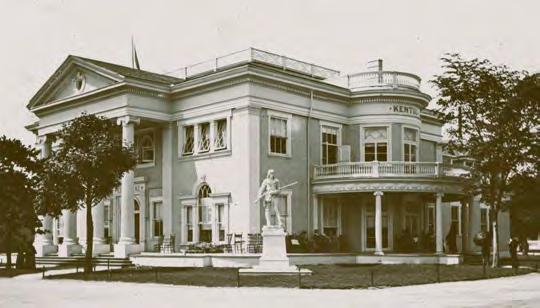
women, as well as a piece of statuary by Yandell, who also sculpted the caryatids on the Woman’s Building.
Kentucky had a pavilion in the Mines and Mining Building that featured the Mammoth Cave replica. The entrance to the Kentucky Pavilion exhibit itself consisted of an arch of “polished cannel coal twenty-five feet in height and twenty-three feet wide with a doorway twelve feet wide and twenty-two feet high.” Immediately within the arch were displays of coal, iron ore, clays and stone on either side, along with a relief map of the state.
The grouping of the portrait gallery of Kentuckians by the Filson Club included “General Zachary Taylor, Jefferson Davis and Abraham Lincoln, General Breckinridge, General John Hunt Morgan, and a collection of portraits painted by Jouett that included Humphrey Marshall and Chief Justice Marshall.” Also displayed were busts of Governor Robert C. Wickliffe and Alexander Campbell by sculptor Hart.
Among the historical relics displayed in the Filson exhibit room were “Daniel Boone’s gun, knife, hunting shirt, powder horn and other trappings used in the pioneer days, George Rogers Clark’s watch, Henry Clay’s sword, General John Hunt Morgan’s rifles and silver-mounted saddle, relics of the mound builders, cups and other trophies won by Kentucky horses, and the first piano ever made in Kentucky.”
Among the exhibits of national interest was the “Lincoln piano, which is constructed of wood secured at the old Lincoln homestead in Kentucky. Medallions of Lincoln and his wife are carved on the front of the piano, and between them are carved the notes and a verse of ‘The Old Kentucky Home.’ ”
Kentucky also had a parlor in the Woman’s Building at the fair. Antique furniture from prominent Kentucky homes decorated the parlor room, including chairs from the ancestral homes of the “Great Compromiser, Henry Clay, Elder Brewster of Plymouth Colony fame, and Cassius Marcellus Clay, chief justice of the Supreme Court.” Also in the room was a sofa from U.S. President John Tyler from the White House, a harpsicord from home of General Basil Duke, an antique piano, and portraits of famous Kentucky
“I think the one lesson I have learned is that there is
The entire exhibit was enclosed by a wall at least 18 feet high, which was used for hanging maps and colored photographs of Kentucky scenery. The roof was composed entirely of transparent photographs representing views of different products and scenes in every portion of the state.
Kentucky sustained her reputation at the fair by winning awards in agriculture, minerals and livestock. Visitors to the Kentucky department in the Agricultural Building saw the artistic arrangement of its various products. A medallion of Boone’s head made of tobacco decorated the top of the main arch leading to the exhibit, while magnificent specimens of hemp and tobacco formed other decorations. Kentucky led the world in hemp and tobacco production, and those exhibits were displayed conspicuously.
When the distilling interests of this country were given space at the fair, it was decided to illustrate the process of distilling handmade sour mash whiskey. The selection fell to the Old Times Distillery Company of Louisville, which built a functional two-story distillery and warehouse at the fair. The company won first prize for its exhibit.
The 1893 Columbian Exposition was indeed a world’s fair, where Kentucky was able to showcase its valuable resources to the world. But the fair also was a showcase for the rest of America, and it gave notice to the world of what it would become.
n All quotes are from Louisville Courier-Journal newspapers from 1892 and 1893.
n The Filson Club is now known as The Filson Historical Society. n Thank you to historian, author and lecturer, Daniel Gifford , for sharing a chapter from his book Benefactors of Posterity: The Founding Era of the Filson Historical Society, 1884-1899.
Lettice Pierce Bryan was born near Danville in 1805. She became known for publishing a cookbook, The Kentucky Housewife, in 1839. Her collection of “receipts” for food (and more) provided key lessons for running a household in that era.
Incidentally, the word “recipe” is derived from the word “receive.” Recipes often are referred to as receipts, probably because they are received from others.
The Kentucky Housewife is different from today’s cookbooks in several ways. First, Bryan assumed the reader had a basic knowledge of cooking using the equipment of the times, such as a hearth and, later, a wood-fired stove. Second, measurements for ingredients—such as handfuls,
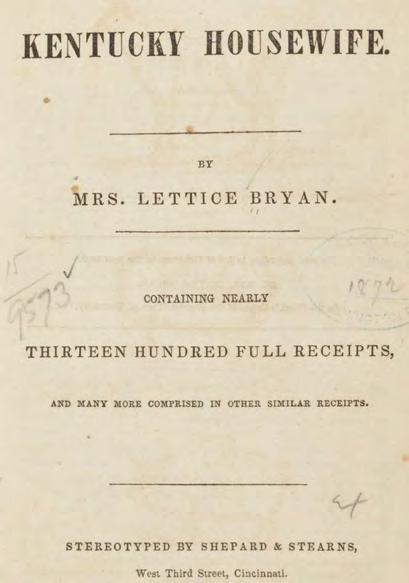
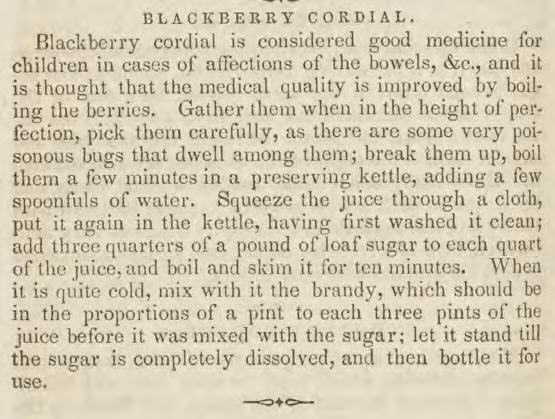

spoonfuls or a tea-cupful—were widely used. The standard measurements of teaspoons, tablespoons and cups did not become popular until the late 1800s.
The Kentucky Housewife contains more than 1,300 recipes for foods with common ingredients such as turkey, cranberries, corn and shote, which is a young pig. Many had African and Native American origins. The book also includes recipes and advice for preserving foods and making wine, and producing medicines, cosmetics, perfume and cleaning products. Something to keep in mind is that the ingredients listed in the recipes had been raised at home, as processed and packaged foods


were not yet available, and stores were not abundant in Kentucky in the 1830s.
The Kentucky Housewife included practical instructions and remedies for ailments and accidents, such as how to treat a toothache and how to soothe and heal burns.
Bryan wrote and published her cookbook from her home in Monticello, where she lived with her husband and nine young children. During this time, her husband, Edmund Bryan, was training to be a physician. After the publication of The Kentucky Housewife, Lettice’s family lived in Washington County and Grayson County. She had a total of 14 children and died in 1885 at age 72 in the home of a daughter and son-in-law.

This photo was taken looking south in front of what is now the Grant County Court House in downtown Williamstown. Although the date of the photo isn’t known, because the circus came to town more than once, below is an 1893 advertisment for the circus.

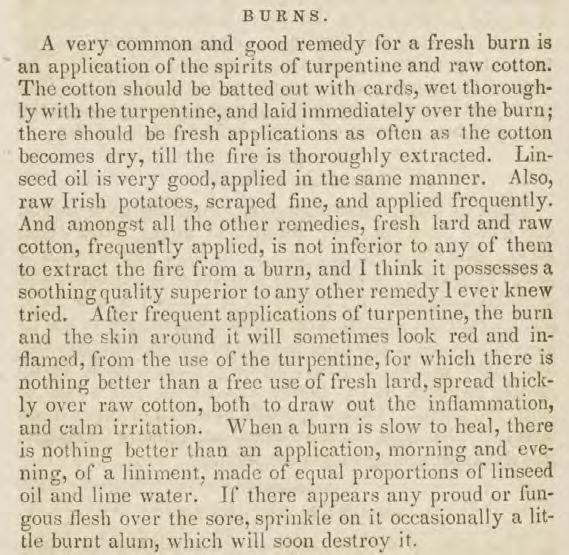
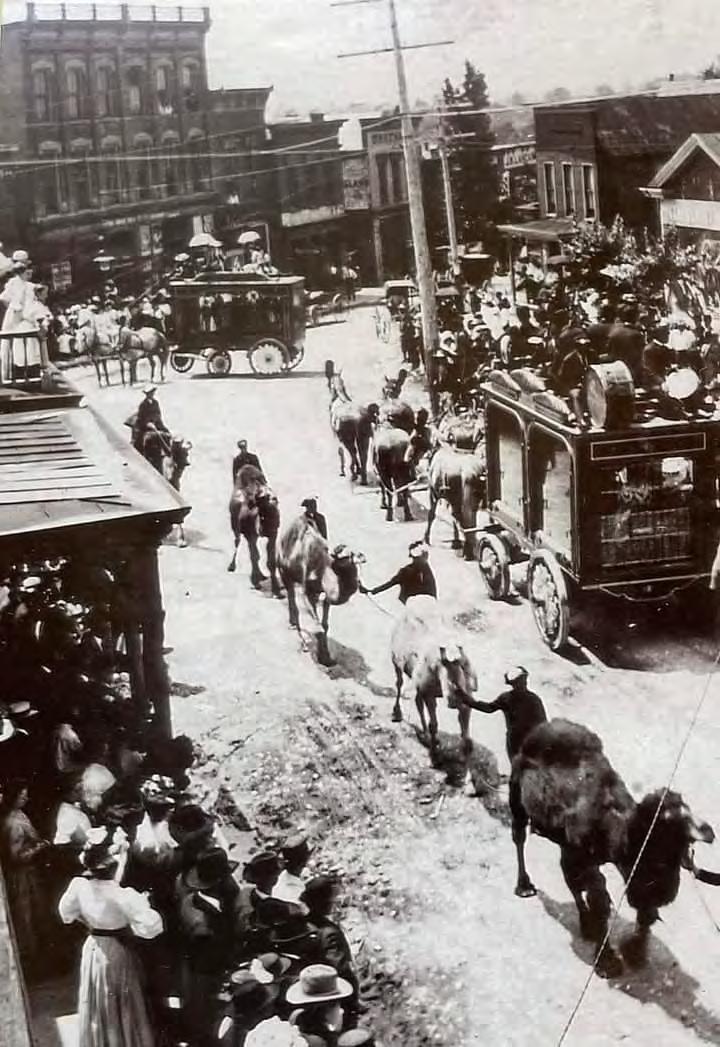
By Mark Mattmiller, Cynthiana
In the late spring of 1868, an incident took place that was profound in terms of its impact on the history of Kentucky agriculture. The strange event occurred on a small tobacco farm, and to this day, the exact cause has not been explained. George Webb of Brown County, Ohio, was setting out his tobacco beds when he ran out of the tiny seeds. His farm was across the Ohio River from Augusta (Bracken County), and that is where he could purchase more seeds.
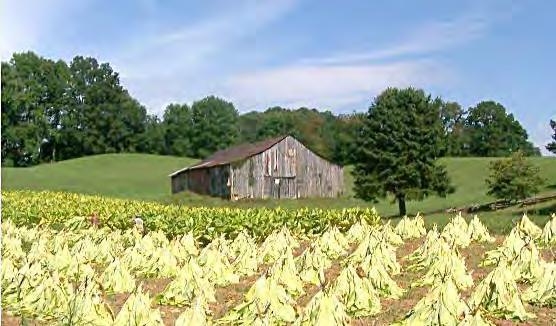
He sent two of his helpers to ferry across the river, buy seeds, and return to the farm to finish with the beds. No problems developed. The plants grew, were set out, and at the end of the summer, the finished product was cut and housed in good order. But there was a noticeable difference in the plants that grew from the Kentucky seeds and all the other seeds previously used. That difference was easy to see from when the tiny plants first sprouted until the crop was cut and housed. The plants were light in color, and lighter in weight and texture. The leaves were larger than those normally seen, and like the leaves, the stems and stalks were also light in color and weight. It was the first time the tobacco world had seen the light plants. What followed was a strain of tobacco that eventually was called “white tobacco.”
Webb’s handling of the plants was important. Either by plan, design or just accident, the lighter plants had been set apart from the fields planted with the traditional seedlings. What Webb did know was that he had something new. What he didn’t know was whether it was good and had potential, or if it was bad and a waste of time to pursue. He kept some of the seeds produced by the light tobacco. He planned to set out a field of the new strain in Kentucky far removed from other tobacco so that it couldn’t be crosspollinated. And that is what he did.
This new variety of tobacco soon spread into the northern counties of Kentucky. In short order, it was discovered that the new strand had an absorptive quality
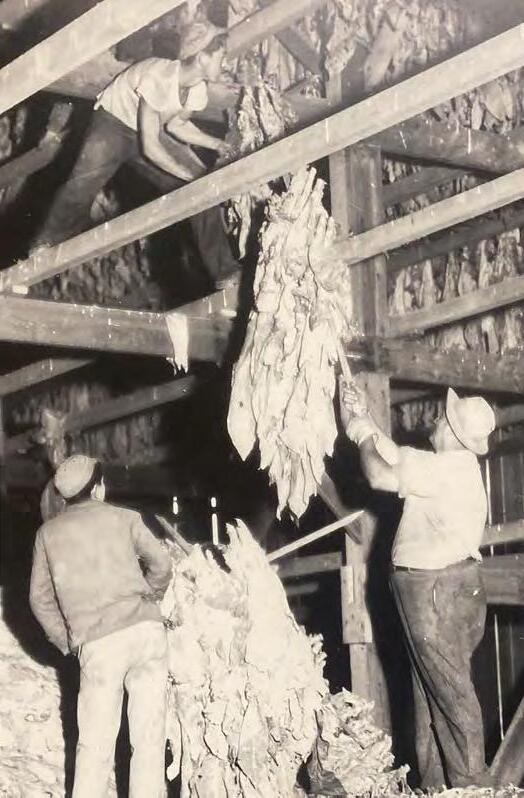
that was far higher than that of any other tobacco type. At that time, almost all tobacco grown went to the manufacture of plug/chewing tobacco. Cigarette production was in its infancy. Plug tobacco was made by indoctrinating cured tobacco with different sugars and syrups and then pressing it into squares. The new white tobacco absorbed more than twice its weight in the liquids. If you cut into a sample of plug tobacco made from the earlier dark types, you would have found the gumminess between the leaves and not incorporated throughout the leaf. The new light leaf soaked up the sugar and syrups. When the absorptive quality of the white tobacco was discovered, it became a must-have product for the plug tobacco industry. The first cigarettes did not have any white tobacco in them, and they had a harsh and bitter taste. When cigarette makers added white tobacco into the blend, they discovered that cigarettes made with the new tobacco had not only a better taste but also were much milder. Soon, that was all the smokers wanted. It became apparent early on that the white burley tobacco was necessary for cigarette production. If the producers wanted to sell cigarettes, they had to have the white tobacco, and because of soil and climate, it could be raised only in parts of Kentucky.
What we now know is that the small isolated unexplained incident of Webb’s discovery changed the industry. The entire social and business fabric of the 21 Kentucky counties in the burley district became shaped by the strange new leaf.
Without doubt, a tiny event defined a way of life for thousands of Kentuckians.
Waveland Tea Tuesday – every Tuesday at Waveland Historic Site in Lexington. For more information, call 859.272.3611.
Lafayette Fete: A Grand Finale 200 Years in the Making at Thomas D. Clark Center for Kentucky History in Frankfort on May 17. For more information, call 502.564.1792 or visit history.ky.gov/event.
SCKCC Welcomes Home Vietnam Veterans at South Central Kentucky Cultural Center in Glasgow. Exhibit through 2025. For more information call 270.651.9792 or visit kyculturalcenter.org.
Frontline Kentucky: Kentucky on the World War II Homefront at the McCracken County Public Library in Paducah on May 8. For more information, call 270.442.2510 or visit mclib.net.
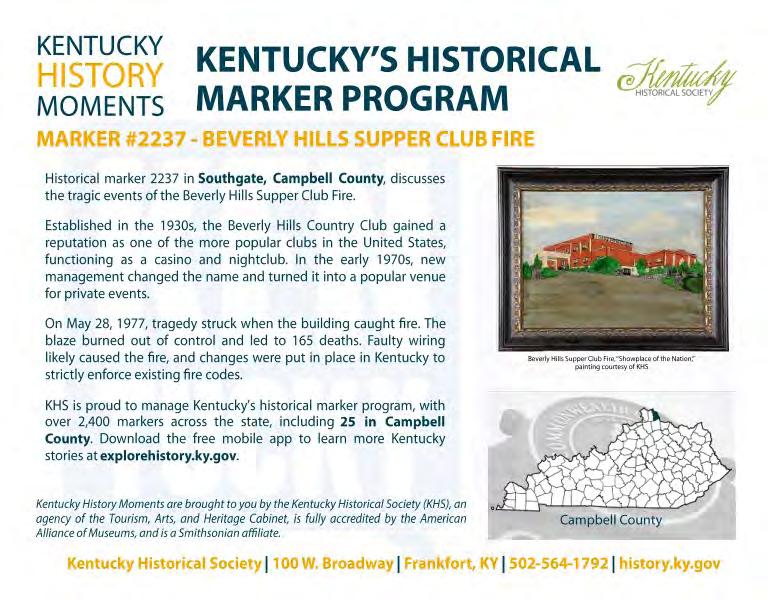
Reach 120,000 readers a classified ad in Kentucky Explorer! Classified ads are only $50 per issue (up to 25 words). Contact Deborah Kohl Kremer at deb@kentuckymonthly.com or call 888.329.0053.
KENTUCKY ANTIQUE TRAIL — Trail brochure/maps are in Kentucky state welcome centers and member stores. Visit KentuckyAntiqueTrail.com. Contact info@AntiqueTrail.com or call 256.797.5640.
ANTIQUES & VINTAGE MARKET
Lawrenceburg Fairgrounds, 351 E Eads Pkwy., Lawrenceburg, Indiana. The first Sunday of the month MayOct, next show May 4, 2025, 6 am-3 pm. Over 200 dealers. 513.702.2680, lawrenceburgantiqueshow.com. (M-O)
LIKE-NEW VINTAGE CADILLAC —
1984 Cadillac driven in the Pegasus Parade and ridden in by Diane Sawyer. One owner, like-new interior. Looking for best offer. “It needs to go to someone who’ll love it much as I do.” Call 270 536-3232 if interested
BOOK FOR SALE —
George Graham Vest: The Life and Times of Dog’s Best Friend chronicles the life and career of Frankfort native, jurist and legislator George Graham Vest. The book is by Stephen M. Vest, a cousin, who is known for his command of the English language. $26.95 plus shipping. To purchase, call 888.329.0053 or visit shopkentuckymonthly.com
BOOK FOR SALE —

WANTED Paying cash for large diamonds; collections of vintage wrist and pocket watches; gold and silver coins; sterling flatware and serving pieces; gold and silver jewelry; collections of arts and crafts and pottery; antique advertising signs; antique walking canes; pocket knives; collections of antique guns and swords; military collections; early handcrafted crocks and jugs; musical instruments; call Clarence, buyer for more than 35 years; 606.531-0467.(F-D)

Reflections of a Scared Soldier Boy in Vietnam: God, Redlegs, and Blueboys by Robert Adams. My combat tour with the First Air Cav Division. 859.806.5199. (A-A)
BOOK FOR SALE —

Highlighting rural Kentucky events from 1880, this adventurous story by C.W. Shumate waited 145 years to be shared. Butler Books available at cwshumate.com (M-D)
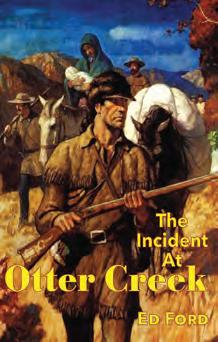
A crazy thing happened to physician/history buff Dr. Wyatt Henderson while he explored some old gravesites in the Otter Creek area in Madison County. A raging flood and a blow to his head carried him away to the 1700s—in the era of Daniel Boone, early Boonesboro and war with hostile Shawnees. Yes, this book has a little timetravel action. The rest is history or—at least, compelling historical fiction.
Ed Ford’s The Incident at Otter Creek is both an enjoyable 175-page read and a Kentucky history account. Though the specific scenes are created ones with easy-todiscern dialogue, Ford appears to have a firm grasp of the actual historical events surrounding his narrative. It takes only a bit of the reader’s imagination to drop oneself into the flow that has elements of romance, adventure, and people acting bravely and for each other while standing up to danger and hardship.
Ford has written six books, two plays and several articles about the Civil War. He owns a public relations firm in Richmond.
By Steve Flairty

Each of Georgetown resident Michael Crisp’s books include numerous places to explore in the Commonwealth. An example is, “Go fishing at Land Between the Lakes,” I have done this several times, fishing for crappie with my father and others. What a grand memory.
Each place features an important quote. For example, “eat fried chicken at Claudia Sanders Dinner House in Shelbyville” includes a pithy saying from Colonel Harland Sanders: “Don’t be against things so much as for things.”
“See a batcave, Carter Caves State Resort Park, Olive Hill” is where my wife and two young kids (both now in their 60s) spent our first camping trip together back in the late 1960s.
Although I figure that I have about half of the 200 places yet to visit and experience, I have drunk “moonshine from a mason jar” in Eastern Kentucky, paid my “respects at the Vietnam Veterans Memorial” in Frankfort, slept “in a teepee, Wigwam Village,” and drove “slowly under a covered bridge” several times.
By William E. Ellis
The Kentucky Bucket List Part 1 and Part 2, by Michael Crisp, Remix Books, 2012 and 2016, $14.99 each (H)

When a childhood adoration for show horses turns into an adult obsession about perhaps the greatest one of all time, it just might result in a book. It did for Emma Hudelson, whose Sky Watch: Chasing an American Saddlebred Story is the masterful culmination of her journey to discover how a horse becomes a legend, believing that, if she could capture that magic, it might help her understand her own passion for Saddlebreds.
Sky Watch performed at a high level, winning four world grand championships and 12 world titles. Spurred by watching videos of the champion, the author searched to find more compelling details. Although Sky Watch’s owner was reluctant to talk, the horse’s trainer and rider, Mitch Clark, who owned stables outside of Danville, provided helpful information
Hudelson recreates the drama of epic competitions between Sky Watch and another superstar Saddlebred, Imperator, while first painting a full backdrop.
This is Indiana resident Hudelson’s debut book.
By Steve Flairty
Sky Watch: Chasing an American Saddlebred Story, by Emma Hudelson,



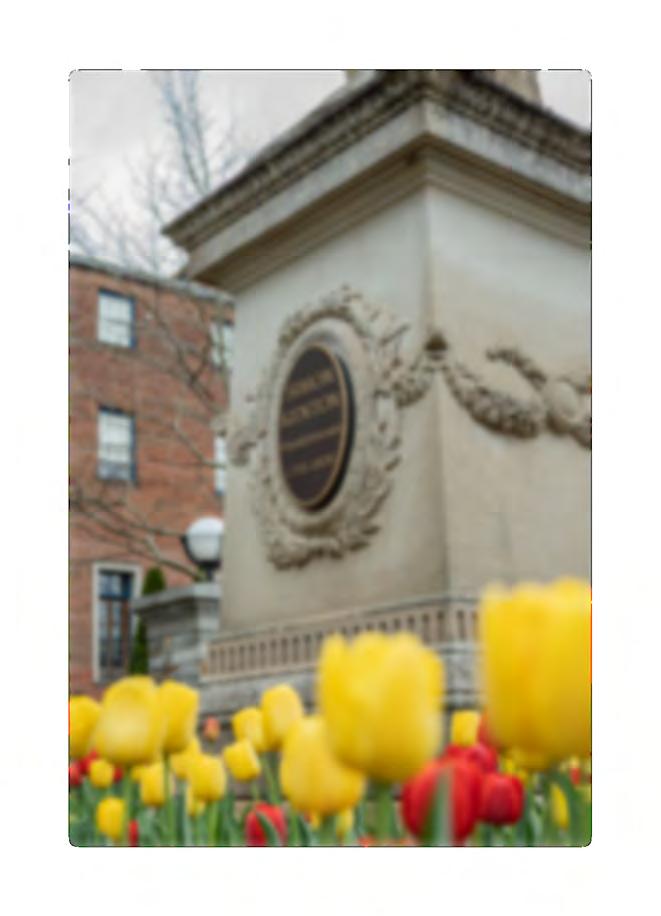

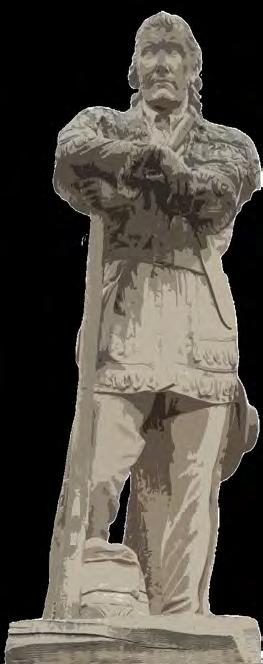
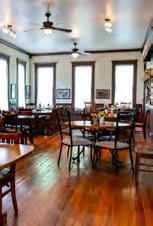

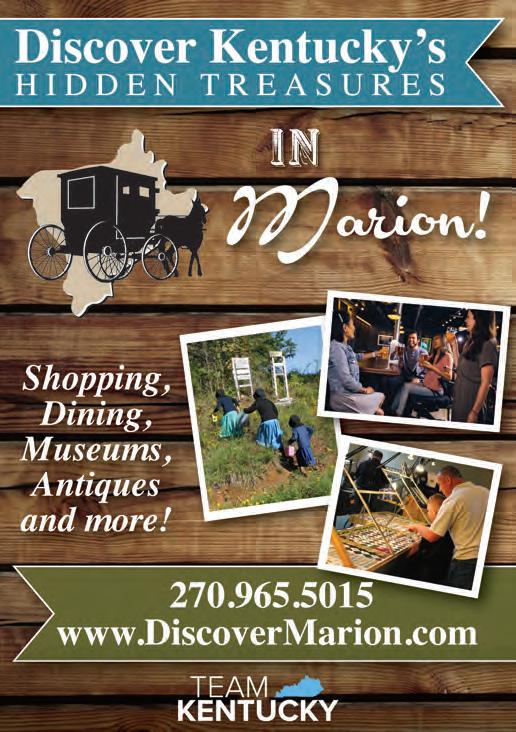
BY BILL ELLIS
My teaching career at Harrodsburg High School, Shelby County High School, Lees Junior College, Eastern Kentucky University and Baptist Seminary of Kentucky spanned more than 40 years. Teaching was my main occupation. Along the way, I had to study and earn degrees to qualify to teach. Research and writing first a thesis and then a dissertation became part of the process. While conducting my research, I studied and wrote about some interesting people.
President Frank McVey of the University of Kentucky and President E.Y. Mullins of Southern Baptist Theological Seminary figured in my master of arts in history thesis at Eastern Kentucky University. “The Kentucky Evolution Controversy” of the early 1920s was the theme, and both men opposed mandating creationism in Kentucky’s public schools.
I settled on a dissertation about Mullins when it came time to finish my Ph.D. in history at UK. He was an intellectual who wrote several books and was quite liberal for the time in the conservative Southern Baptist Convention. But when push came to shove, he opposed the election of Catholic Al Smith in the 1928 presidential election.
Another interesting character, a somewhat liberal Catholic named Patrick Henry Callahan, also opposed the election of Smith, aka “The Happy Warrior.”
I became intrigued about why this occurred. Don’t you usually expect a Baptist to vote for a Baptist or a Catholic for a Catholic?
Callahan grew up in Cleveland. The son of Irish immigrants, he was named for the American patriot of “Give me liberty or give me death” fame. He attended Spencerian Business College and worked for millionaire Mark Hanna for a short time before heading off to Louisville to work with the Glidden Varnish Company.
A handsome man well over 6 feet tall with the “gift of gab,” he became an excellent salesman. Before long, Callahan helped organize and then ran The Louisville Varnish Company as president from 1908 until his death in 1940. Callahan’s company innovated the production of paint and other products, supplying firms such as the Harley-Davidson Company with its needs.
The Louisville Catholic believed that industrial problems could be resolved if owners took more interest in the welfare of their workers. In collaboration with Father John A. Ryan of the Catholic University of America in Washington, D.C., Callahan initiated a profit-sharing plan for his company in 1912. At the conclusion of a business year, stockholders received a fixed income and then workers and stockholders received an equal share of profits.
Fortunately, I was able to interview several individuals who knew him well, including his daughter, Edith; 13 former employees of Louisville Varnish who always kindly referred to Callahan as “The Boss”; Barry Bingham Sr., publisher of the Louisville Courier-Journal and Times; and John Herchenroeder, a longtime newsman and ombudsman of the papers.
Callahan kept up with current politics, reforms and issues through
“The Callahan Correspondence,” circular letters he sent to friend and foe alike.
Except for the 1928 presidential election, when he opposed fellow Catholic Al Smith, Callahan always favored Democratic Party candidates and was generous with his funds and support.
After the defeat of Smith, Callahan worked diligently for the candidacy and then election of Franklin D. Roosevelt in 1932. After Roosevelt’s victory but before his inauguration during a banking crisis, Callahan wrote presidential secretary Louis Howe, “You all have selected one helluva time to have Roosevelt [elected] President, just when the whole country has gone haywire … Tell the president no one wishes him more success.”
• • •
Much of the research and writing for my thesis and dissertation took place while I was burning the midnight oil. Thank goodness we had electric lights in my tiny office in the garage and my tiny Smith-Corona typewriter was working well.
All of this took place early in my academic career at EKU, where I was teaching a full load, teaching offcampus classes when available, taking correspondence courses and, along with my working wife, laboring to pay on a mortgage and feed and clothe two growing red-headed children.
I recall this time quite literally as “The Best Years of Our Lives.”
EKU was always generous about funding my trips to research Callahan archives at The Roosevelt Library in Hyde Park, the Notre Dame Library and Catholic University.
Early one summer at Catholic U., I secured a room on campus at the beginning of a hot spell. At the time, a group of priests was attending a meeting. The first night my room was hot as … well … you know. I complained to the front desk that the air conditioning was not working. As I was leaving the next morning, the telephone rang in my room. A young female voice said, “Father Ellis, your air conditioning will be working when you return.” I thought about saying “Bless you, my child,” but simply thanked her.
At the time, the papers of the National Catholic Welfare Conference were housed in the basement of an old abandoned Catholic school. For more than a week, I walked more than a mile each way across a four-lane, limited-access highway in the hot June sun. Fortunately, I found an old upright typewriter that I could use for my notes. The place was deserted.
All of this happened way back in the late 1970s and early ’80s, when I was in my late 30s and early 40s and much more flexible.
Callahan claimed that in his younger days, he had a serious problem with liquor and became an opponent of the manufacture and sale of alcoholic beverages. Remember, this is Kentucky, the home of a vaunted whiskey with an “e” in its name.
In many ways, Callahan became the quintessential “Progressive” of the period. He remained in the Democratic Party but often locked horns with the Kentucky Irish American, a Catholic viewpoint newspaper in Louisville, and also with conservative Protestant sources.
While Callahan maintained his Prohibition sentiments, owing partly to the alcohol problems of his children, he was firm on other

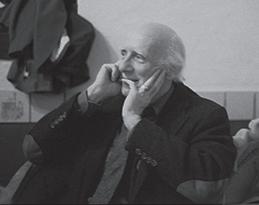

Progressive stands. He was a staunch opponent of the Ku Klux Klan and even corresponded with its members.
I have been fortunate to study a number of other famous Kentuckians, including Mullins, Robert Worth Bingham and humorist Irvin S. Cobb, but—if and when I get to heaven—I look forward to meeting up with Callahan and sharing with him a story and a laugh or two.
I was never able to do Callahan justice with an award-winning biography. I published a couple of articles about him and gave a paper about his life at a Catholic History Association meeting at St. Mary’s College in California.
Overwhelmed with academia, I decided to self-publish Patrick Henry Callahan (1866-1940): Progressive Catholic Layman in the American South and was satisfied with my efforts.
Readers may contact Bill Ellis at editor@ kentuckymonthly.com.




BY GARY GARTH
Ihad planned a multi-day fishing trip for early April. It would have involved about a half-day of travel, then a couple of days on the water with an old angling friend and colleague whom I don’t see as often as I would like. While sorting through piles of gear that included waders, a float tube, two generic “fishing bags” and more rods than I could possibly need, my wife walked into my office carrying a cup of coffee and a slice of fresh-from-the-oven chocolate cake. She hoisted a bag from the couch, tossed it on the floor and sat down.
“Want some cake and coffee?” I shook my head. “No, thanks. Not yet.” I was thinking where I might have put a small box of recently tied Clouser minnows and was trying to decide if I might really need the float tube. I probably wouldn’t need the tube. The fly box might be in the Filson bag.
“Is it in the Filson bag?” Katy asked, reading my mind.
“You know … It might be.”
With a practiced eye, Katy surveyed the cluttered room, which had once been a one-vehicle open carport and has a too-much-stuff-forthe-space feel about it. Katy is well familiar with my chaotic pre-trip packing routine. We’ve been married more than four decades.
She forked a bite of cake.
“Did you see the weather forecast?”
Katy is the weather authority in our home, a by-product, I’ve long suspected, of her being the daughter of a farmer. My father-in-law seemed to always have one eye on the sky and could read the weather like I can read

a newspaper. At last count, she had six weather apps installed on her phone and is seemingly on a firstname basis with our local TV weather prognosticators.
My idea of checking the weather is looking out the window, which currently revealed clouds and a stiff, warm breeze from the south. The cloud cover might help, but I was hoping the wind would calm. I was still thinking about the fly box, which I’d now decided was not in the Filson bag but in a drawer of an old hutch that had once filled a corner of my mother’s kitchen but is now packed with fishing gear, camping supplies and a rarely used fly-tying vise and sits in a corner of the former carport, a form of recycling with a practical purpose.
“No, not yet,” I said, noting the weather question. I was rifling through the hutch drawer, which—to my surprise—held an old Martin fly reel that I thought my daughter Sarah had but not the box of Clousers.
“What’d they say? The weather people, I mean.”
“Storms tonight, then 10 to 15 inches of rain over the next few days. Would you like for me to look in the Filson bag for the Clouser box?”
I shook my head, having decided the Clouser box was in the pouch of my fly vest. “It’s not in the Filson bag. I know where it is.
I think I’ll have some cake.”
I retreated to the kitchen and returned with a chunk of cake and a glass of milk, tossed another bag off the couch and sat down.
“How much rain? Ten or 15 inches? Not possible.”
“I hope not. But that’s what they’re saying.”
About halfway through my cake and milk, my phone dinged. It was a text from Alan, my fishing partner.
“Seen the forecast? Big rain!! Maybe we should reschedule.”
Katy forked her last bite of her cake. “Who is it?”
“Alan. He thinks we should reschedule.”
She was looking at one of the numerous weather apps on her phone. “Might be a good idea.”
While I was typing a response, Katy reached into her pocket and handed me the Clouser box.
“I found this.”
“Where?”
“In the Filson bag. I looked while you were in the kitchen.”
The 2,506-acre Ashland Wildlife Management Area in northern Lee County is permanently closed. The closure stemmed from a
property sale, a condition that was included in the 2005 agreement between the Kentucky Department of Fish and Wildlife Resources and the property owner, Ashland Inc. Following the sale of the land, the agreement establishing a WMA was terminated.
According to a KDFWR news release announcing the management area’s closure, under most WMA agreements, landowners retain ownership while allowing public access for hunting, fishing and wildlife watching, while the state game agency provides property management guidance, enforcement and other services in coordination with the landowner. •
In another public land switch, the section of McCracken County’s West Kentucky Wildlife Management Area known as Tract 1 has been closed to public access. The closure removed about 655 acres of the WMA from public use. The remaining 5,760 acres of the Western Kentucky property remain open.
The property closure is part of an economic development project that was announced late last year by Gov. Andy Beshear.
In agreeing to give up part of the West Kentucky WMA, the fish and wildlife commission agreed to exchange the Tract 1 property for 1,068 acres in Fulton County. This property is being managed as part of the Obion Creek WMA and is open under statewide regulations.

MAY 3
MAY 8
MAY 24
JUNE 7
JUNE 13
JUNE 21
JULY 5
JULY 12
JULY 26
AUG 15
AUG 30
SEPT 27
GENE SIMMONS BAND
WE ARE MESSENGERS
FLO RIDA with YIN YANG TWINS
TRACY LAWRENCE & GARY ALLAN
OLE 60
BOOGIE WONDER BAND
WEIRD AL YANKOVIC
AARON LEWIS
ROCK THE DAM 8
TRAVIS TRITT
THE JOHN PRINE BAND HAIRBALL

Readers may contact Gary Garth at editor@kentuckymonthly.com

BY WALT REICHERT

Warning: This column may horrify hardcore rosarians. If you come across it accidentally, you may be entitled to compensation.
Rose lovers typically leave their beds bare of anything but roses. It may be because they consider any other plant unworthy of their attention. Or they may have better reasons. Roses are heavyfeeding plants, and they don’t appreciate competition from others. Many rose species, but especially hybrid teas, require a spraying regimen that is not necessarily compatible with other species sleeping in the same bed. Overcrowding the rose bed can contribute to a decrease in airflow and a resulting increase in incidence of the dreaded disease blackspot. Nevertheless, if done carefully, planting companions in the rose bed can not only enhance the beauty of the roses but also can attract beneficial insects, curb disease and
fight weeds that take advantage of bare soil.
Avoid large woody shrubs, such as lilacs or the larger hydrangeas (‘Annabelle,’ etc.) that will compete with the roses for precious sunlight. Having said that, hydrangeas can make an excellent background plant for a rose bed. Their large dark green leaves and white blooms set off the colors of the roses.
Avoid plants that are overly aggressive, such as the mint family or the native wild strawberry. I once planted native strawberries in a perennial bed, and within two years, the bed was almost nothing but strawberries. They had smothered nearly everything else. (Native wild strawberries have excellent flavor and are not the same as those that show up in lawns, but I discovered the groundhogs would beat me to them.)
To thrive, your roses require full sun, so avoid plants that do not
tolerate the heat or burn in sunlight, such as hostas and ferns.
Except for miniature and groundcover types, roses tend to grow tall and leggy, their blooms coming at the end of long canes. Their lower stems, therefore, tend to lose leaves and become downright ugly. Companion plants that stay low to the ground can hide the roses’ lower limbs and, at the same time, avoid competing with leaves and blooms higher up.
Annuals that stay low and work well with roses include pansies, petunias, million bells, lantana and dwarf marigolds. The latter two not only will smother weeds, they also will attract beneficial insects to the rose bed. Marigolds also repel some insect pests. Be careful of variety selection, as many marigolds get large. Those varieties described as “French” tend to be shorter; “African” varieties tend to grow too tall for rose beds.
Low-growing perennial rose companions include catmint (nepeta), salvia, coreopsis, lamb’s ear and verbena. Verbena, with its blue or purple flowers, sets off the colors of yellow or pink roses. Wormwood (artemisia), with its silver foliage, is an excellent low-growing perennial that makes a striking background for the entire rose bed. While most bee balm (monarda) cultivars would compete too strongly with rose blooms, the variety ‘Pardon my cherise’ stays down to about 10 inches and would make a good rose companion as well as a
pollinator magnet.
Remember that good airflow is key to keeping down rose diseases such as blackspot and powdery mildew, so any tall-growing companion should come with light, airy foliage that will not impede airflow.
Lavender is a good choice. It thrives in the same soil that makes roses happy; it is attractive to beneficial insects, while repelling some of the bad guys; and the English lavenders stay low or have foliage that will not inhibit airflow in the rose bed.
Allium species also work well in a rose bed. The globe-shaped purple blooms of allium contrast nicely with the more intricately folded roses, and the foliage doesn’t compete with roses. The same is true of cosmos, though it is an annual rather than a perennial. Yarrow, with its ferny foliage and flat flower heads in many colors, is another excellent choice for a rose bed. Yarrow is popular with bees and other pollinators.
It is not out of the question to use the rose bed to do double duty as a food producer. Low-growing vegetables that would thrive among roses would include lettuce, radish, carrots, onions and garlic. Strawberries also would do well in a rose bed, but be sure to get the cultivated—not the wild—kind.
Everbearing strawberries, such as ‘Ozark Beauty’ and ‘Fort Laramie,’ would be good choices because they produce fewer runners than June bearers such as ‘Earliglow’ and ‘Jewel.’
If you include edible plants in the rose bed, be careful with spraying. As noted previously, roses—especially hybrid teas—usually require spraying fungicides to hold disease at bay. Always read the label of any fungicide you may use in the rose bed to make
sure it can also be sprayed on food crops. And note the withdrawal time before harvest on the label as well.
Finally, if you include pollinatorfriendly plants in the rose bed, you need to avoid spraying insecticides on your roses. That may be hard to do if you have a Japanese beetle or aphid outbreak in the garden, but there is no sense in growing plants that attract
pollinators if you are going to kill them with insecticides. Japanese beetles can be controlled with handpicking; aphids can be knocked off plants with a strong blast of water. Your roses and their bedfellows will thank you for the extra effort.
Readers may contact Walt Reichert at editor@kentuckymonthly.com





Brilliant Exiles
American Women in Paris, 1900-1939, Speed Art Museum, Louisville, through June 22, 502.634.2700
Side by Side Exhibit
Kentucky Museum, Bowling Green, through June 21, 270.745.2592
Charley Harper: Birds and Beasts
Headley-Whitney Museum of Art, Lexington, through June 22, 859.255.6653
A Life in Color
National Quilt Museum, Paducah, through Oct. 7, 270.442.8856

Louisville Orchestra’s In Harmony Tour
downtown Mount Sterling, 502.587.8681
4 5 6 7 8
JJ Grey & Mofro and The Marshall Tucker Band
Paramount Arts Center, Ashland, 606.324.0007
Mother’s Day
Agathe and Adrien: N.Ormes
Norton Center for the Arts, Danville, 859.236.4692
Dogman: The Musical
The Carson Center, Paducah, 270.908.2037
Shucked
Kentucky Center, Louisville, through May 18, 502.584.7777
Mama, I’m a Big Girl Now Lexington Opera House, 859.233.3535
Missy Raines & Allegheny
Bluegrass Music Hall of Fame and Museum, Owensboro, 270.926.7891
We Are Messengers
Where the JOY Is Tour, Beaver Dam Amphitheater, 1.800.514.3849
Rutter’s Requiem
Glema Mahr Center, Madisonville, 270.821.2787
Snow White
Market House Theatre, Paducah, through May 17, 270.444.6828
Comic Invasion LIVE!
The Crowded House, Madisonville, 270.821.4171
The Velvet Bombers and Roulette
Gene Simmons Band
With The Iron Maidens, Beaver Dam Amphitheater, 1.800.514.3849
Mayfest Arts Fair
Gratz Park, Lexington, through May 11, 859.425.2590
Friday After 5, Owensboro riverfront, fridayafter5.com Wilco in Concert
Iroquois Amphitheater, Louisville, 502.368.5865
18 21 22 23 24
Pack Horse Librarians of Kentucky
Frazier History Museum, Louisville, 502.753.1049

Thibault Caron photo
Met Opera Presents Salome
The Grand Theatre, Frankfort, 502.352.7469
Abbey Road on the River Waterfront Park, Louisville, through May 26, 216.678.1909
Beaver Dam Strawberry Fest
Beaver Dam, through May 26, 270.967.1100
Flo Rida with Ying Yang Twins
Beaver Dam Amphitheater, 1.800.514.3849
Cruizin Keys Dueling Pianos
The Virginia Theater, Somerset, 606.679.6366
Bonepony and Barrett Band
Friday After 5, Owensboro riverfront, fridayafter5.com
Railbird Music Festival
The Red Mile, Lexington through June 1, railbirdfest.com

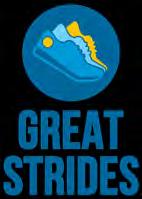




The sun is again shining, and the water has retreated within its banks. Spring has come to Kentucky, and it is greener than any Irish heath.
As a longtime Frankfort resident, I’ve been flooded (no pun intended) with notes of concern and sympathy, for which I’m truly grateful. Please understand that I live atop a hill high enough off the Kentucky River that it would take a Noah-magnitude flood to wash us away.

STEPHEN M. VEST Publisher + Editor-in-Chief
It’s been a rough month for 70 of Kentucky’s 120 counties and towns such as Rumsey and Calhoun, where I had one of my early jobs (and wrote about the 50th anniversary of the 1937 flood), Hopkinsville, Rabbit Hash, Carrollton, Louisville, etc. Muddy flood water reached places on par with 1850, 1937 and 1997. My church, built in 1815, has never had water, but this time, it reached the steps and begged to come in. The First Baptist Church a few blocks away was more hospitable (aren’t they always?) and is working to repair the sanctuary floors and fellowship hall. Help where you can, when you can.
While many of my neighbors on the Kentucky River suffered great hardship and inconvenience, none of us were surprised like those folks you sometimes see on the evening news. You’ll never catch a Frankfortonian saying, “I can’t believe I was flooded again.”
The Kentucky River is a living thing—a benevolent and beautiful monster. It comes and goes where it wishes, and those of us who know its history understand that its earliest white settlers—those around Buffalo Trace Distillery—chose to live there because of its consistent flooding, a trait upon which you could depend.
Many people along the Kentucky River spent the fall and early winter building structures—shanties and flatboats—next to the river. They filled them with goods, including bourbon whiskey, which the spring flood waters would carry away as far as New Orleans, where the skiffs would be converted into houses, some of which still stand in today’s Ninth Ward.
One such account is offered by John G. Stuart, who, in 1806, traveled from Cleveland’s Landing (Clays Ferry), south of Lexington, to New Orleans, where he sold his wares. Like hundreds of others, he then walked home via the Natchez Trace—covering 20 to 30 miles a day—to begin the process again. Paddle-wheel steamboats wouldn’t appear on the Mississippi for a few more years.
Stuart’s journal can be found at the Kentucky Historical Society in downtown Frankfort. It describes his encounters along the way, such as this entry from late February: “This evening there came down a boat com’d by John Sublitt for Hart & Co., the crew are a specimen of what I may expect to see in my voyage—drinking, swearing and kicking.”
Due to a long drought, Stuart and his companions did not travel far before being stranded by low waters. When steady rain finally arrived in April, the boatmen were stranded again when the river rose too high. Shortly thereafter, they resumed their journey, passing Frankfort in late April. His boat entered the Ohio River at Carrollton and passed 18-Mile Island and Louisville before landing a mile above the Falls of the Ohio. His cargo was unloaded and reloaded at Shippingport (an island town accessible from Portland).
Below the falls, Stuart joined 30 other boats in a flotilla. He reported several encounters with “friendly Indians,” including a pair who spoke some English, whom he met 70 miles below Louisville. He traded them a half-gallon of whiskey for two venison hams.
The convoy passed many wrecked boats in the month between Paducah and Natchez. Stuart reached New Orleans on June 3 and enjoyed for the city briefly. Stuart returned to Natchez, and on June 24, he, J. Sudduth, and “Mr. Lester” set out on foot for Kentucky. Despite a lingering illness contracted in New Orleans, the trio was back in the Commonwealth by the end of July, telling the tales of nights spent in Indian huts along the way.
While we were not surprised by the flood, we’re assured that, if our river is of a mind to cozy up to a barstool at Garrett’s Golf Garage or take a private table at Bourbon on Main, there is little to nothing we can do to dissuade its desire.
Vest can be contacted at steve@kentuckymonthly.com

Handcrafted bourbon, graceful Saddlebred horses, and iconic Southern comfort food perfected by Colonel Sanders himself. Designer shopping and luxurious places to stay. Close to the city without being in the city and full of small town charm. Paired with authentic Southern hospitality, it’s easy to see why ShelbyKY is known as Your Bourbon Destination® and the Saddlebred Horse Capital of the World. In other words, ShelbyKY is everything you love about Kentucky.
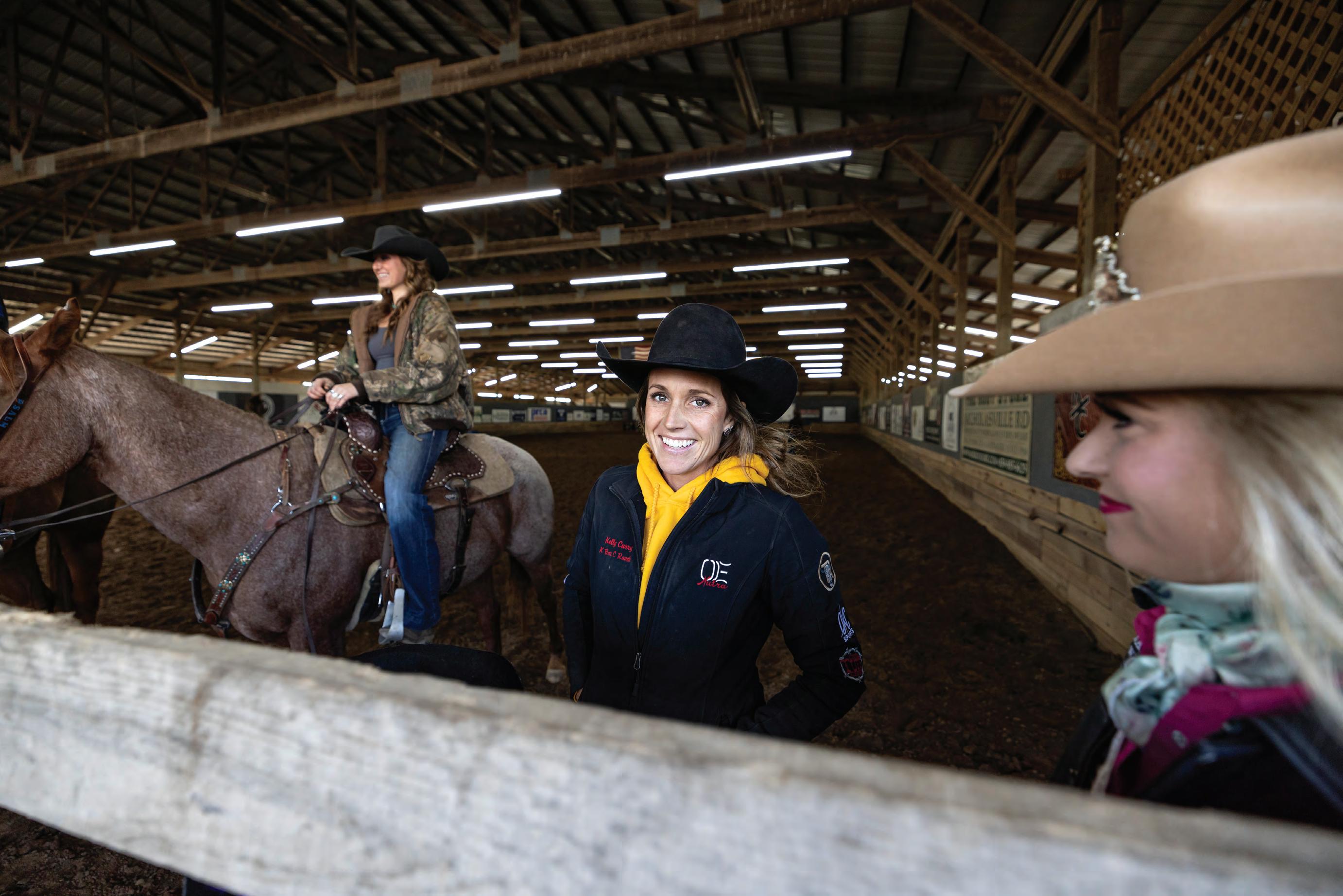
Horses shape Kentucky's cultural identity, combining our heritage with tradition. Our unbridled spirit is clear in the horse farms that dot the landscape and the small-town festivals that bring communities together.